Cornell Report
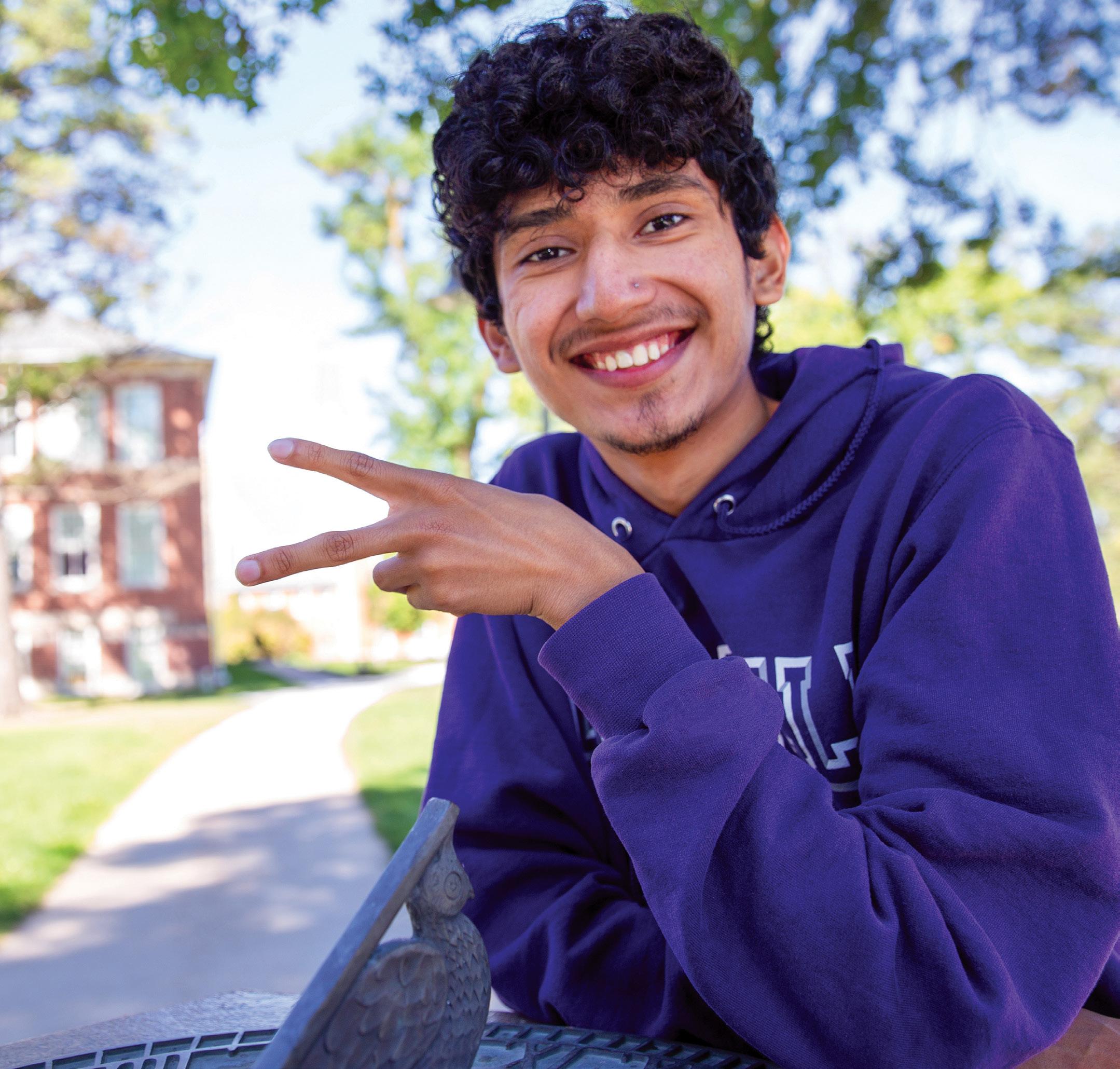
No. 1 Volume 46 / FALL 2022
Becoming Greater > Than
Cornell students gather on the Orange Carpet to form the symbol associated with the Greater > Than campaign.
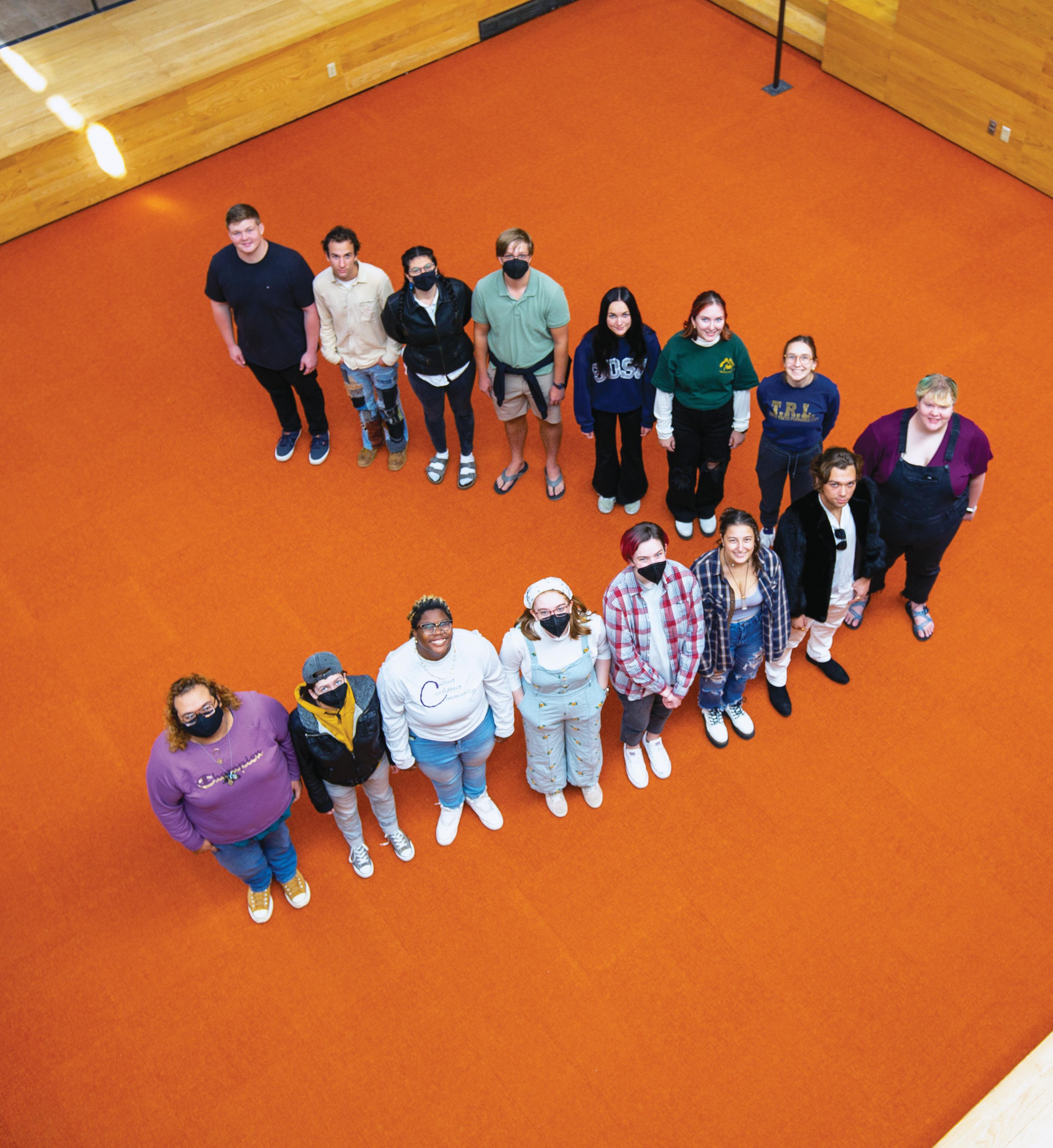
The generosity of 9,130 donors made this the largest campaign in the college’s history.
ON THE COVER: Jonathan Azenon ’24 arrived from Culpeper, Virginia, during Cornell’s Greater > Than campaign and has used Russell Science Center nearly year round since then. Read his story on page 21.
PHOTO BY ALLAN RECALDE
ALLAN RECALDE
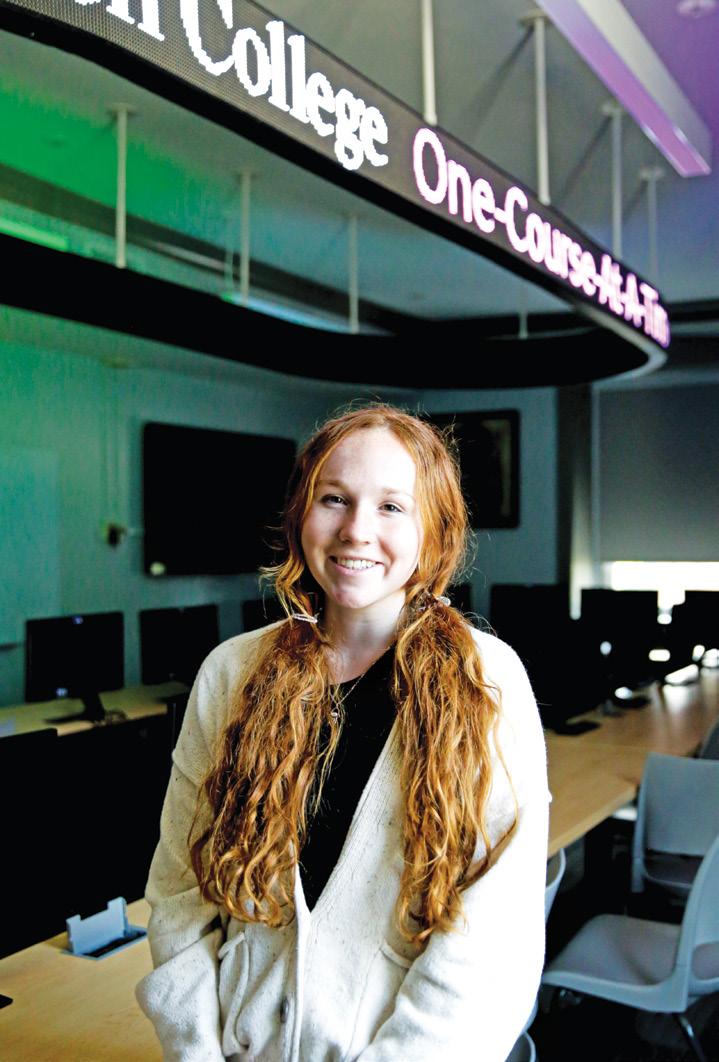
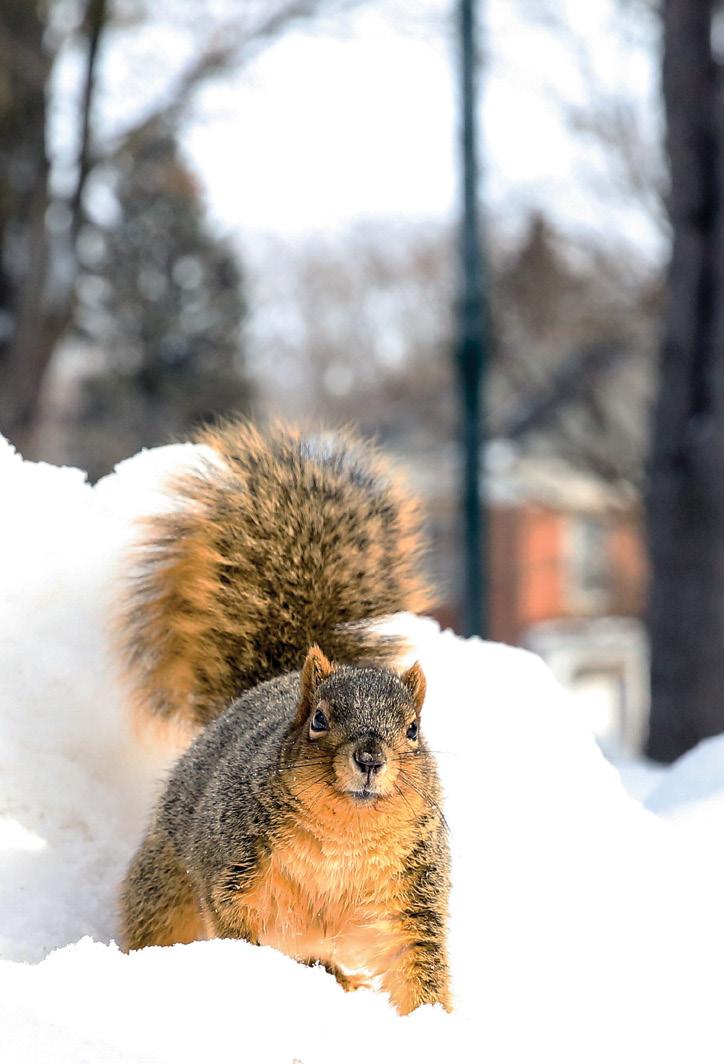


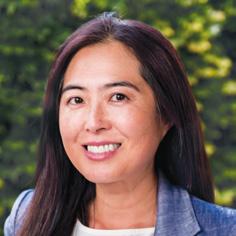
42 Alumni News 54 In Memoriam 56 Last Word 2 You Said 4 Around the Hilltop 16 Ram Report D E P A R T M E N T S CONTENTS L I F E A F T E R CO R N E L L Hiromi Nakazawa ’01 Facing big challenges 41 Don MacDonald ’67 Rodeo life: A special thing 18 Jeffrey McCune ’99 Scholar who teaches disobedience 31 1 CORNELL REPORT | FALL 2022 Becoming Greater > Than 19 32 18 things to love about Cornell
Cornell Report
EDITOR
Dee Ann Rexroat ’82 drexroat@cornellcollege.edu 319.895.4241
You Said
RESPONDING TO THE ANNOUNCEMENT OF PRESIDENT OF THE COLLEGE EMERITUS LES GARNER’S PENDING RETIREMENT AS PRESIDENT AND CEO OF THE GREATER CEDAR RAPIDS COMMUNITY FOUNDATION
Julie Bryant ’88
After having a positive impact on Cornell for many years, Les Garner went on to do great things for the Cedar Rapids community and surrounding areas. I wish him well in retirement.
Cornell Report is published fall, spring, and summer for alumni, parents, faculty, staff, and friends of the college by the Office of Marketing and Communications, Box 1648, Cornell College, 600 First Street SW, Mount Vernon, IA 52314-1098
Contact Us

GIFTS TO CORNELL ADDRESS CHANGE 877.MVERNON (683.7666) giving@cornellcollege.edu
ALUMNI ENGAGEMENT OFFICE 319.895.4204 alumni@cornellcollege.edu
REGISTRAR 319.895.4372 registrar@cornellcollege.edu ATHLETICS 319.895.4230 athletics@cornellcollege.edu ADMISSION 800.747.1112 admission@cornellcollege.edu cornellcollege.edu/cornell-report
Professor Emeritus Sue Astley
Congratulations on your second round of building up and supporting an Eastern Iowa institution! Happy retirement.
Professor Emeritus Diane Crowder Retirement is wonderful! Congratulations on completing a productive and eminent career. You made everything better.
IN RESPONSE TO A PICTURE SHOWING ALUMNI PARENTS WITH CHILDREN STARTING AT CORNELL
Lisa Kay Fry Runkel ’02
Oh, gosh. Does it mean you’re old when people you went to school with are alumni parents? (Don’t answer that.)
Mike Khouri ’99
Love this pic and the continued family ties to the school.
IN RESPONSE TO A PHOTO OF EMERITI FACULTY CELEBRATING THE REV. RICHARD THOMAS’ 92ND BIRTHDAY
Peter S. Bryant
Happy Birthday Rev. Wonderful gathering of many special Cornellians. Wishing you all the best.
Mark D. Reed ’82
Appreciated his pre-marriage counseling!
IN RESPONSE TO THE POST: GOODNIGHT KING CHAPEL, GOODNIGHT PED MALL, GOODNIGHT TO RAMS ONE AND ALL. GOODNIGHT IOWA, GOODNIGHT PURPLE ROCK, GOODNIGHT LAST DAY BEFORE THE BLOCK.
Lam Jin ’85
Good morning King Chapel, Good morning Cornell … from me across the globe in Malaysia.
We learned the identities of the volleyball players in this photo from the summer issue: Barb Thomas Woods ’88 (left) and Michelle Dye Goodall ’89. See an update on Goodall on page 48.

ONLINE-ONLY OPTION
To opt out of the printed magazine and be notified by email when each issue is online, contact the editor at cornellreport@cornellcollege.edu
BE PART OF THE CONVERSATION
We are delighted to publish letters and social media mentions. Tag @cornellcollege to be considered on social media. Send letters to cornellreport@cornellcollege.edu or Cornell Report, Box 1648, 600 First St. SW, Mount Vernon, IA 52314-1098. Submissions are edited for style, length, and clarity.
 ASSISTANT EDITOR Lisa Gray Giurato
DESIGN
Amy Belice Graphic Design
CLASS NEWS CONTRIBUTORS
Maxwell Love Joshua Waldorf
ASSISTANT EDITOR Lisa Gray Giurato
DESIGN
Amy Belice Graphic Design
CLASS NEWS CONTRIBUTORS
Maxwell Love Joshua Waldorf
Volume 46 / FALL 2022
No. 1
Amy Joan DeGroot-Hammer ’91
Happy birthday!!! What a wonderful group of life changers!!!
2
CORNELL COLLEGE ARCHIVES
SKY ROOM MEMORIES
Your photo of the Sky Room as it is now, and the description of it as “once a coveted dorm room”: Coveted is so right on! I lived in the Sky Room my senior year, 1963-64, with Penny Gilchrist Holliday ’64, Ginny Wright Boylls ’64, and Susan Hope Harris ’64. We were ecstatic when one of us was lucky enough to have number four for the draw for rooms. Other students, who had numbers one through three, wanted to be in the new building, Dows Hall, and so we were in! The room had plenty of windows, built-in bookshelves, a sink, and a skylight. It was the huge attic of Rood House. In my day, there were window seats built in under the windows and on one, I used to stretch out and read the Des Moines Register on lazy Sunday mornings, ’til Ed Gibbs ’64 got off work in the Bowman dining hall and we could meet up and have lunch together. The other window seat served as our “sofa,” in front of which was our coffee table—my dad’s World War II foot locker. We four spent many long hours drinking coffee and solving personal (boyfriends), campus (grades, courses, profs), national (JFK assassination), and worldwide problems. During graduation week, four close friends of ours, who were lucky enough to get the room for the following year, toilet-papered the entire room. Given that the room had a very high ceiling, it was an impressive feat.
Carol Wells Saberian ’64 Austin, Texas
TITLE IX @ 50
I came to Cornell in the fall of 1971 from a very large high school where I had played competitive tennis. However, Cornell only had a men’s tennis team. I went out for the men’s team, but that did not work out well. I am happy to say Cornell developed a women’s tennis team, and I was able to play once again for my school. Shout out to some of my fellow players, including my doubles partner Vickie Anderson Stolte ’77.
Nancy Rawson ’75 Cedar Rapids, Iowa
CANNON VS CANON
The article titled “Canons in King Chapel” in the current edition of the Cornell Report contains an interesting (and, to my ear, amusing) spelling error. It contains the words canon and cannon. It uses both words to mean a gun or guns. A cannon is a kind of gun. However, canon means something else. Because a canon is in one of its definitions a kind of music, we have an amusing pun. No doubt, students have over the years heard canons on the inside of King Chapel and cannon on the outside!
By the way, I learned when I checked the dictionary that the plural of cannon is cannon.
Professor of Computer Science Leon Tabak Mount Vernon, Iowa
As we all know, a canon is a clergyman, usually of the Roman Catholic or Anglican church, who might be seen as an odd creature at Cornell and could very well have been locked up in a dungeon underneath King Chapel. But I’m quite sure it’s cannons as in heavy artillery pieces, that were stored under the Chapel.
Craig Kuehl ’66 New York City, New York
FALL OPENING CONVOCATION SPEAKER
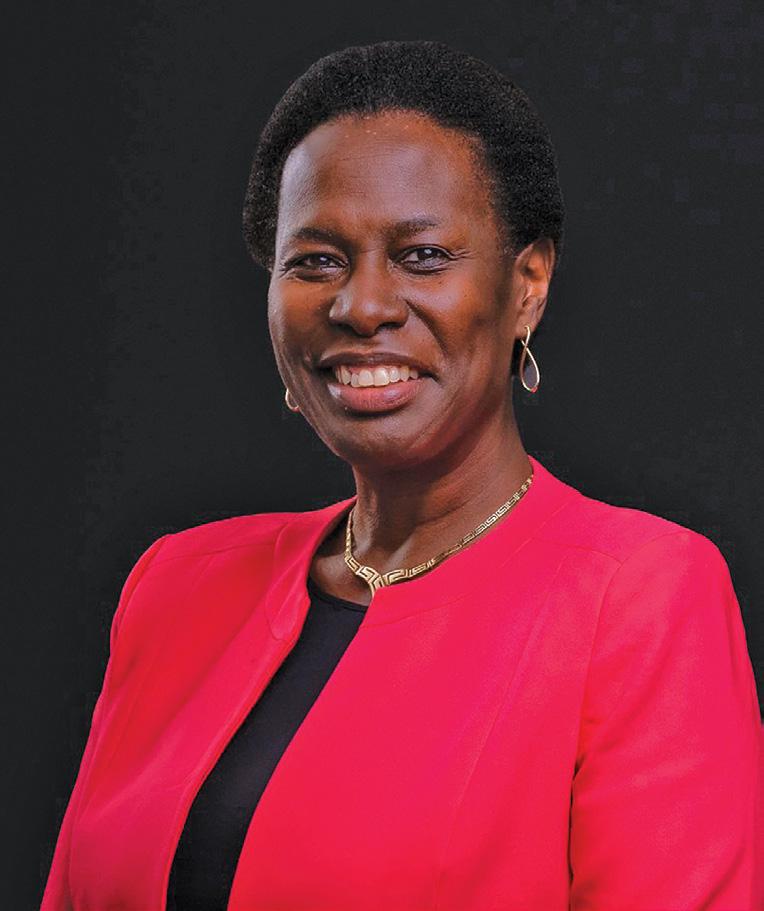
Said on campus
“My hope is that your community will collectively … do hard things. One, engage meaningfully across differences. Two, maintain an attitude of gratitude daily. And three, develop a servant’s heart.”
Marylyn Scott, assistant dean for student transitions at the African Leadership Academy in Johannesburg, South Africa
3 YOU SAID
Around the Hilltop
 ARDEN KWAN ’83
ARDEN KWAN ’83
4
Professor Emeritus of Art Tony Plaut ’78 exhibited “An Array of Wonders: Past, Present, and Future,” at Peter Paul Luce Gallery in McWethy Hall this fall. Among the more than 100 works in the show is the self portrait figure, “Now,” seen in the foreground.
A century of Phi Beta Kappa
For exactly 100 years Cornell’s Phi Beta Kappa inductees have signed this historic book, graduated, and left to do great things. The inaugural 1922 cohort included:


Governor of Iowa and Secretary of Treasury under President Theodore Roosevelt, Leslie Shaw, Class of 1874
Chief engineer for Chicago’s Navy Pier, Edward Shankland, Class of 1875
Cornell’s first female faculty member with an endowed professorship, Professor of Mathematics Mary Burr Norton, Class of 1877
Goodwill founder Edgar J. Helms, Class of 1889.
Although there are too many outstanding Phi Beta Kappa members since then to list them all, we offer these three notables: Pulitzer Prize-winning Lincoln scholar Don Fehrenbacher ’44; the first woman appointed as a U.S. District Court judge in the Middle District of Tennessee, Aleta Grillos Trauger ’68; and Black Engineer magazine Scientist of the Year Tahllee Baynard ’97.
And one of our most recent Phi Betes: Sunny Kahn ’21, a Pakistani native now attending Harvard Divinity School and serving as a Cornell College Young Trustee.
5 CORNELL REPORT | FALL 2022
MEGAN AMR
A closeup of the first page of Cornell’s official Phi Beta Kappa signature book shows Cornell’s first female faculty member with an endowed professorship, Mary Burr Norton, Class of 1877.
Where are they now?
10 years ago the Cornell Report featured a cover story on several promising graduates. We caught up with four of them and are delighted to report on their lives today.
Lisa Chen ’12
MAJORS: International relations, women’s studies, and politics
LIVES: New York City
CAREER: Chen is the interim chief people officer at Prospect Schools, a kindergarten through 12th grade, diverse-bydesign charter network that serves students in New York City. Before joining Prospect Schools, she was managing director of operations at the six-campus Harlem Village Academies. Prior to that, she was a director of operations manager with Uncommon Schools. She began in education when she joined Teach For America. Chen also taught middle school at Achievement First and was an assistant principal at Success Academy. She holds a master’s degree in teaching.
PERSONAL: Chen is an avid traveler, foodie, and is training with her husband to run their first New York City Marathon in November 2022.

Jonathan Frazier ’12
MAJORS: International relations and environmental policy
LIVES: Seattle, Washington
CAREER: Frazier worked for the U.S. Department of Transportation until 2017, when he became a student at the University of Washington’s Master of Urban Planning program in Seattle. Since graduating in 2019 he has worked for the city of Seattle as a transportation planner. He works on the early phases of transportation projects, typically those that address roadway safety and building out the city’s network of bicycle lanes.
PERSONAL: Frazier is married to Emily Krauter Frazier ’11 and they have an infant son.

6 AROUND THE HILLTOP
Kayla Prestel ’12
MAJOR: Theatre
LIVES: New York City

CAREER: Prestel joined Actors Equity Association, the professional actor’s union, in 2019. After a two-year pandemic hiatus when live theater was paused in New York City, she was a puppeteer with Bated Breath Theatre Company in their production “Chasing Andy Warhol” (above).
Three years ago Prestel also opened Feel Good Pilates, a boutique pilates studio in lower Manhattan. She reports the business survived the pandemic and continues to grow. In 2021 she earned her 200-hour yoga certification.

PERSONAL: She ran a half marathon in Rocky Mountain National Park in July. In November she marks her eighth anniversary in New York City and reports: “I love it more as each year passes.”
Diego Verdugo ’12
MAJORS: Economics and business, Spanish
LIVES: Phoenix, Arizona
CAREER: After 10 years with Principal, Verdugo’s career in the financial services industry continues to evolve as he advances through the ranks. In 2020, he joined the InvestmentNews 40 Under 40 list. He now serves as executive vice president for the Phoenix chapter of the Association of Latino Professionals for America. As a board director for Junior Achievement, Diego also remains committed to helping address the needs of underrepresented communities. In 2021 he obtained the status of certified financial planner and is now pursuing a master’s degree in financial planning.
PERSONAL: He and his wife are raising two daughters.

7
Alumni bring Norton the dino to the Hilltop


In the 1980s Cornell students established a tradition of taking pictures with Sinclair dinosaurs around eastern Iowa. So when a group of alumni noticed a Facebook post about a gas station removing one of the green dinosaurs, they set out on a mission to try to buy it.

“It started six months into COVID lockdown as a silly conversation of ‘What if
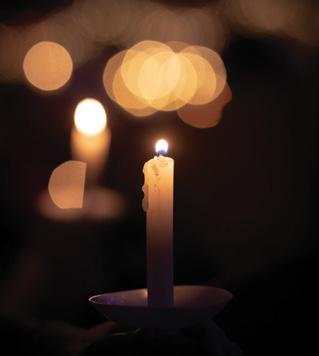
DEE ANN REXROAT ’82
1977
FIRST INFORMAL PRIVATE
HOME 1978 1979 LESBIANS JOINED THE MEETINGS WITH THE SUPPORT OF DIANE CROWDER, FRENCH
WOMEN’S STUDIES 1993 THE LESBIAN, GAY, AND BISEXUAL CORNELL ORGANIZATION FAMILY AND FRIENDS FIRST MET ON-CAMPUS PROFESSOR LACEY ESTABLISHED THE LITERATURE OF AIDS CLASS c. 1996 1996–97 FAMILY AND FRIENDS CHANGED ITS NAME TO ALLIANCE 1980 2000
FIRST “OUT” GAY FACULTY MEMBER HIRED: STEPHEN LACEY ‘65, ENGLISH
MEETINGS FOR GAY CORNELL STUDENTS AT LACEY’S
AND
8 AROUND THE HILLTOP
During Pride Month in June 2022 Cornell College shared stories and celebrated along with our LGBTQIA+ community by uplifting their voices on social media. Professor of Art History Chris Penn-Goetsch helped create this timeline, which provides a proud history from 1977 to 2022.
we could put that dinosaur on campus!’” says Mandy Landuyt ’99. “It gave us something to focus on that was fun and exciting, and was a very uniting thing for those of us who wanted to be involved.”

What began as a diversion ended after a two-year journey during which the alumni learned that Sinclair Oil and law enforcement were looking for the exact dinosaur they were in line to purchase.
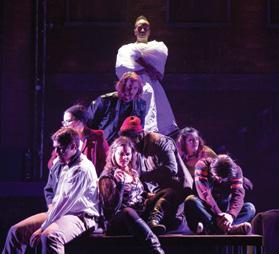
Months and many phone calls into this saga, they discovered they couldn’t legally purchase the dino. But after helping Sinclair locate the dinosaur, Landuyt says the company donated one to the group to thank them for unintentionally solving the puzzle of their missing dino.
“I say we’re like the Scooby Doo gang—that we pulled the mask off the villain and revealed the truth of the situation, even though we initially had no idea what we were really involved in,” Landuyt says.
The alumni named the dinosaur Norton, after Norton Geology Center. In July 2022 Norton was installed in Cole Library, where its director, Greg Cotton, says he’s amused and more than happy to have it: “I like that vibe that it’s going to give off that we are not stuffy, and we’re fun and approachable.”
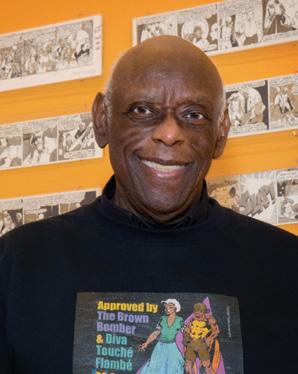

Alumni who supported this project are excited to take new pictures with the dinosaur and see the next generation of Cornellians experience some of the fun they had as students. One
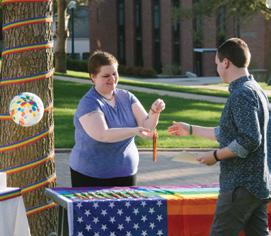
of those new students is Landuyt’s daughter, Emma Landuyt-Krueger, who arrived in August with the Class of 2026.
“She’ll be able to say, ‘Hey, my mom and her friends brought that dinosaur here!’ It’s extra awesome to think maybe she’ll have as much fun with it,” says Landuyt.
Mandy Landuyt ’99 poses with Norton in Cole Library after moving her daughter in as a new student.
2003
THE PRODUCTION
“THE
FIRST OPPOSITE-SEX MARRIAGE INCLUDING A TRANSGENDER PERSON IN CORNELL’S ALLEE CHAPEL ON FEB. 14 2005 FIRST RAINBOW (LGBTQIA+) GRADUATION 2018 2021 PROFESSOR OF ART HISTORY CHRISTINA PENN-GOETSCH TAUGHT QUEER EYE FOR ART HISTORY RUPERT KINNARD ’79, “FROM CORNELL TO CATHARTICA: A HISTORY OF CATHARTIC COMICS” EXHIBITION 2022 2011 PROFESSOR CROWDER TAUGHT CLASSICS OF LGBT LITERATURE AND FILM; PROFESSOR OF SOCIOLOGY ERIN DAVIS TAUGHT TRANSGENDERED LIVES AND GENDER DIVERSITY 2018 CORNELL’S THEATRE DEPARTMENT PRODUCED THE MUSICAL “RENT” 2010 2020 FIRST SAME-SEX MARRIAGE IN CORNELL’S ALLEE CHAPEL ON MAY 2 2009 DEE ANN REXROAT ’82 9 CORNELL REPORT | FALL 2022
STUDENTS ACROSS CAMPUS HELD A CANDLE-LIT RALLY TO SUPPORT
OF
LARAMIE PROJECT“
Center for the Literary Arts
A conversation between generations of Cornellians
ON THE FIREPLACE mantle inside the literary home, the Van Etten-Lacey House, you can read a rather famous piece of work—a recipe for a strong cocktail called the Archbishop, often mixed up and served by the late English Professor Stephen Lacey ’65 during one of the many literary soirees held when he lived in the historic home. VEL, as it’s known, opened 10 years ago but has a history of being “home” on campus for students. Today, students participate in FreeWrite Fridays while baked goods’ delicious smells waft from the kitchen’s oven doors. Before Lacey’s legendary gatherings, Winifred Mayne Van Etten, Class of 1925, lived in the home and hosted tea parties for students.
WEB EXTRA
Want to mix up Lacey’s cocktail? crnl.co/lit-mix
“NOTHING exemplifies lifelong learning like the literary arts,” Professor of English and Creative Writing and Robert P. Dana Director of the Center Rebecca Entel says. “It’s so essential to everything we do—lifelong reader, lifelong writer, and someone who seeks community with other readers and writers.”
Entel says that former visiting writer and novelist Lauren Groff is attributed with saying, “Art is a long, unending conversation between generations.”
and taught by writers of color. It also sponsors professional panels composed of publishers, freelancers, journalists, editors, and agents. Classes make use of the VEL, for writing, workshop, performances, and printshop projects.
Three student-led publications are hosted by the Center: Open Field, BOOM, and a research-based chapbook with varying themes. The chapbook series publishes both faculty and students; the first theme was “Poetry for Your Mama” and a later theme included “Poetry for Resistance.”
Students have benefited from numerous opportunities, such as the creation of the Student Literary Arts Board (SLAB), which hosts events, write-ins, a chapbook, and fosters community.
WEB EXTRA View CLA’s visiting and distinguished writers at crnl.co/cla
THE CENTER HOSTS a Visiting Writer Series that includes interdisciplinary class visits and readings that serve the greater campus community in a way that is not common at small colleges. The Center is essential to student engagement; it allows firstyear students and non-majors to get involved in the world of literary arts.
Internships have provided students with opportunities not common for undergraduates and in conjunction with Cornell’s Ingenuity in Action (experiential learning component of the Ingenuity core curriculum), students earn credits toward their degree with funded internships.
Do you have memories you’d like to share about the literary arts at Cornell? If so, email cornellreport@cornellcollege.edu
The Center hosts Distinguished Visiting Writer courses in rotating topics and genres, often with a social justice component
Students also complete work-study projects in arts administration and events planning and publicity. Donors from the Class of 1958 funded arts administration internships where each summer two students work and learn at the historic Chautauqua Institution. The Center offers internships with Cleaver Magazine, allowing
10 AROUND THE HILLTOP
a deeper understanding of the editorial and publishing industry.
Former vice president of SLAB Kendra Aquino ’19 held two internships while at Cornell, at the Chautauqua Institution and Cleaver Magazine, where she is an editor today.
“My internship at the Chautauqua Institution was a formative and rewarding experience,” says Aquino. “While you are there you are immersed in inspiring lectures and small group writing workshops with world-renowned authors and poets. Being a literary arts intern gave me the confidence to pursue my craft and helped me create genuine and lasting connections to the literary community.”
After Cornell, students have gone on to earn Fulbright awards, M.F.A., and M.A. degrees.

Alumni have published their work and gone into careers in editing, journalism, library science, freelance writing, education, story development for video game companies, and grant writing.
WEB EXTRA
Read Clare McCarthy’s ’16 reportage for Iowa Watch on the history of refugees in Iowa at crnl.co/refugees
FORMER SLAB member and Fulbright award winner Randy Santiago ’ 18 is in an M.F.A. program at the University of Miami, has numerous publications, and started a podcast with his brother called Homies of Lit, which Entel says introduces literature to people who might not live somewhere where they can get connected to the literary scene. Novelist Sandra Cisneros reached out to be on the podcast. Cisneros, like Santiago, is from Humboldt Park, a neighborhood in Chicago.
WEB EXTRA
Homies of Lit is on hiatus but you can listen to the episode with Cisneros at crnl.co/homies
ENTEL HOPES that in the future the Center for the Literary Arts will fund more internships for students, be able to fairly pay more high-profile visiting writers and publishing professionals to work with students, and fund students to attend undergraduate editorial conferences, and make the Van Etten-Lacey House more accessible.
WEB EXTRA
Read how Van Etten-Lacey House was built by a book at crnl.co/vel
CORNELL COLLEGE
11 CORNELL REPORT | FALL 2022
Working in the Van Etten-Lacey House, home of the Center for the Literary Arts, Professor of English Leslie Hankins and her students republished three Winifred Van Etten short stories.
Did you take a course at Cornell that has stuck with you during your life after Cornell?
Email us at cornellreport@cornellcollege.edu with the subject line One Course to share your story.
One COURSE
PSYCHOLOGY OF SPORT
Associate Professor of Kinesiology Christi Johnson’s Psychology of Sport course is not just for the sport obsessed, but applicable across life–anywhere a person encounters stress and anxiety along with the pressure to perform. What motivates us as individuals and teams of people? What creates cohesion among the group? What can enhance performance? What triggers aggressive behavior?
“Because of the title of the course, it draws a large number of athletes, and sports is the first thing that comes to mind. But then they start brainstorming about situations where they really are facing pressure in the same way that they would face in sports, and once we start doing that we can break open the skill-set that people use to deal with those situations more effectively,” Johnson says.
She kicks off the course by asking students to imagine contexts in their lives where they face pressure or judgment, or places in their lives where someone else is evaluating the quality of their work. Then she leads the students through the block spending a week each on three aspects of dealing with challenging situations.
“I am so proud of students who get excited about this work,” Johnson says. “Recently, Sophia Hollingsworth and Nina Deer recognized the need for sport psych services on campus. Both advocated for it, and this year we’ve brought in an outside consultant to support our athletes.”
That type of support could be useful to students like junior Colin Konicek, who found the course helpful to him as a Rams baseball player.
“There is a lot more that goes into sports than the physical aspect of the game,” says Konicek. “That is something that gets overlooked. Being able to look into the mindset piece of sports helps identify ways the athlete can perform better with less pressure and anxiety.”

Sophia Hollingsworth ’21 presented her sport psychology honors work at the Association for Applied Sport Psychology’s (AASP) regional conference in 2019 and the national conference in 2020, and Nina Deer ’22 presented her honors project at AASP’s national conference. Deer has also started graduate school at Illinois State.
“It is really remarkable for undergraduate students to present at the national level and is a testament to the passion that they have for this work,” Johnson says.
Soccer player Tyler Davis ’21 embodies Professor Johnson’s advice that confidence is the foundation to motivation.
12
ROBYN SCHWAB AARON ’07
EVERYONE
SPORT PSYCHOLOGY TIPS FOR
 By Christi Johnson
By Christi Johnson
MOTIVATION
Find something you feel confident about and keep your focus on that. Build new skills by “stair-stepping” up from the thing that you already feel confident about. Confidence is the foundation to motivation.
Look for joy in your activities. When we find activities to be fun, we gravitate toward them.
Build community around your pursuits. Having a supportive team or group can help pick you up when your confidence gets rattled and help you find the fun in otherwise challenging activities.
Keep competition to a healthy level. A little competition can enliven motivation, but too much becomes a burden.
WORKING WITH GROUPS
The assumption that most people are just trying to do their best allows us to see others as potential allies. So, assume good intentions until definitively proven otherwise, and then try again anyway.
Work on assertive communication. Very few people will accurately guess how you feel, what you want, or what you need to
be successful. Practicing self-advocacy in a non-confrontational yet assertive way can help you navigate competing needs.
Don’t fear the leader/ boss/coach/teacher … just remember that person is someone who has a special skill set for focusing on a broad picture. If you or the leader are not invested in the group’s goals, find a new group.
ANXIETY
Breathe. Take a deep breath, slowly exhale, and see if you can fix the situation with a calm mind.
Ask yourself how important a high-pressure situation really is. What would happen if you failed? Is it helpful to be so stressed?
Establish a practice (meditation, exercise, yoga, deep breathing, prayer if it fits your beliefs) that allows you to embrace stillness.
You and you alone are responsible for your emotions. No one has the power to “make you feel” a certain way. We have patterned responses to certain situations, and unpacking those can really help us to figure out why those emotions get triggered. But, ultimately, you are responsible for your emotions.
 Associate Professor of Kinesiology Christi Johnson
Gabrielle Zeger ’21 and Gabie Campbell ‘18 meditate inside Allee Chapel in 2018, a practice that Professor Johnson recommends to increase stillness in an anxious mind.
Associate Professor of Kinesiology Christi Johnson
Gabrielle Zeger ’21 and Gabie Campbell ‘18 meditate inside Allee Chapel in 2018, a practice that Professor Johnson recommends to increase stillness in an anxious mind.
13 CORNELL REPORT | FALL 2022
ROBYN SCHWAB AARON ’07
A pocket park has opened in Mount Vernon, bringing life to an alley in the uptown business district. It’s part of a long-term streetscape plan the city funded, but was languishing in the design stage until the Mount VernonLisbon Community Development Group donated the final $50,000–after winning that amount in a community smoking cessation contest. The Mount Vernon Area Arts Council purchased and installed the art.
FROM LEFT: Director of Equity and Compliance Samantha Hebel Perkins ’12, Assistant Dean of Students and Director of Residence Life Dan Chou, and Assistant Director of Residence Life Nicole Casal ’18.

MEGAN AMR
14

Emma, Jackson, Gabriel TOP POPULAR NAMES FOR CLASS OF 2026: 31: NUMBER OF COMMUNITY SPACES IN THE RESIDENCE HALLS 34: NUMBER OF RESIDENT ASSISTANTS 365: NUMBER OF DAYS PER YEAR RESIDENCE HALLS HOST STUDENTS 3,380: NUMBER OF KEYS MANAGED BY RESIDENCE LIFE OFFICE Residence Life Fun Facts 9: NUMBER OF RESIDENCE HALLS ON CAMPUS 4: STUDENT APARTMENT BUILDINGS AND HOUSES ON THE CAMPUS PERIMETER 1,000: NUMBER OF MATTRESSES 16: NUMBER OF TRIPLE ROOMS 12: NUMBER OF QUAD ROOMS 200: NUMBER OF STUDENTS HOUSED IN OLIN HALL, OUR LARGEST RESIDENTIAL BUILDING The Office of Residence Life in Old Sem keeps sets of all the keys to campus. This background image is from one key drawer. 15 CORNELL REPORT | FALL 2022
Ram Report
Coaches are often judged by X’s and O’s, W’s and L’s. At Cornell, coaching goes far beyond what many people see on the competition venue. It’s also about recruiting student-athletes and preparing them for life.
Recruiting at a Division III institution is a year-round effort that requires a whole lot of time, says Head Volleyball Coach and Interim Athletic Director Jeff Meeker.

Coaching today
So much more than winning, losing
By Matthew Levins
“All of our coaches recruit locally and across the country, spending time at tournaments, recruiting showcases, and other events,” Meeker said. “We send thousands of text messages, make so many phone, FaceTime, and Zoom calls, and promote our programs on social media. We bring recruits to campus and go visit them in their homes. Ultimately, with all of the work we do, we are trying to bring student-athletes to campus who will excel in the classroom and in athletics and be engaged citizens on campus and in the community.”
Once those recruits reach campus, even before they start practice, coaches begin another major role—mentoring.
“It’s a challenging world that we are sending these young people out into,” said Brent Brase ’90, head women’s basketball coach. “The rewards of being a coach are awesome. Part of being a coach is helping our student-athletes be in a better place in life once they leave here.”
How do coaches do that?
Depending on the team, it can happen through community service, through fundraising, through creating a family
Women’s Basketball Head Coach Brent Brase ’90, assistant coaches, and the team during a time out.
ATHLETICS 16
CORNELL COLLEGE
atmosphere within the team, and with consistent and open communication.
“We have so many hats we wear as coaches,” said Jerry Frawley, head men’s and women’s cross country coach and assistant track and field coach. “It’s all about building relationships. I like to treat everybody with respect and make sure they know that I appreciate them. Recruiting is all about building a rapport with student-athletes and their parents and coaches.”
BRENT BRASE ’90 HEAD WOMEN’S BASKETBALL COACH
For many of the student-athletes, it is their first extended time away from their parents, so coaches step into that void to provide guidance and advice.
Jackie Sernek ’14, who is in her sixth season as head softball coach for the Rams, said coaches often take a parent role for their student-athletes.
“You have to let the student-athletes know you are there for them,” Sernek said. “They can call me anytime, whether they just need someone to talk to or it’s an emergency.”
Similarly, Head Men’s Basketball Coach Dave Schlabaugh tries to create a family atmosphere.

“I am more like the father figure to them and our assistant coaches are like big brothers,” he said. “We check in with them every day to make sure they are having a good day and everything is going well. A big part of the college experience is making connections and forming bonds.”
Schlabaugh also coaches at the Snow Valley Basketball Camp, one of the nation’s top camps, and has presented at the USA Basketball Coach Academy. Events like these can help in recruiting and add prestige to the program.
Coaches look for ways to actively engage their players in the community through service. Prior to the pandemic Cornell student-athletes representing all 19 intercollegiate sports averaged 2,000 hours of community service. Teams incorporate service into spring break competition trips or even international team trips. Some have adopted local families in need or raised money for cancer research.
Former women’s basketball player Kat Schilling ’13 says Coach Brase gave the team truly remarkable connections with Mount Vernon youth.
“It was through this outreach that I realized how important team chemistry and connections are,” she says. “Seeing the impact our team had in the community empowered me
to go into education at Cornell. I am confident in saying that the Cornell athletic experience and the cohesion of our team created from Coach Brase set me up for success in a multitude of ways.”
Recently alumni who played for the Rams were asked to recount their favorite memories. Few of them mentioned games or competitions. Many instead recalled relationships with teammates and coaches.
It’s that family atmosphere that All-American volleyball player Kathleen O’Connor ’13 recalled: “The major difference between Cornell athletics and other schools was that it was a family. Everyone supported each other and their future endeavors.”
So while those wins are important, it is the atmosphere developed by the coaches that forges a new kind of family, the Ramily—and the bonds that Cornell student-athletes may remember most.
Matthew Levins has been a sportswriter for over 30 years at The Hawk Eye Newspaper in Burlington, Iowa.
“The rewards of being a coach are awesome.
Part of being a coach is helping our student-athletes be in a better place in life once they leave here.”
CORNELL
17 CORNELL REPORT | FALL 2022
Men’s Basketball Head Coach Dave Schlabaugh interacts with forward Marcus Quirk ’22.
COLLEGE ATHLETICS
DON MACDONALD ’67
rodeos sanctioned by the Pro Rodeo Cowboy Association; it is managed and staffed entirely by unpaid volunteers; and it has been in continuous operation for 55 years. It attracted nearly 70 sponsors and more than 7,000 spectators in 2022.
For more than a quarter century and well into his retirement years, Don MacDonald ’67 has played key roles in producing an annual rodeo in his hometown of Evergreen, Colorado. Back in 1995, his son, Darin, needed a service project to earn his Eagle Scout badge. Darin suggested he organize a group of scouts to build a wooden fence 160 feet long and 6 feet high to create a private area for competitors, workers, and storage.
As his son’s scoutmaster, MacDonald approved, and thus began his
commitment to the rodeo. He has helped the rodeo association construct an office building, a ticket booth and entrance, an accessible ramp, new fencing around the arena, an expanded concession area, and a VIP section for sponsors.
MacDonald manages the rodeo association’s 15-acre site and is a member of its board. As the group’s parliamentarian he wrote most of its bylaws.

The rodeo, a celebration of the area’s ranching history, is unusual in several respects: It is one of the few small-town
The two-day rodeo features a parade, a queen and her court, and events for kids, but MacDonald is always busy preparing for next year and working with groups that rent the site.
“Why do I stay involved?” MacDonald said. “It’s the people I work with, the friendships, the reward of watching fans enjoy the show. And when the rodeo is over, I look out at the empty arena and grounds and reflect on what a special thing we accomplished.”
MacDonald’s devotion to community service is matched by his wife, Barbara Birmingham MacDonald ’70, who raises scholarship funds for Achievement Rewards for College Scientists. They met at Cornell when MacDonald was a senior and Barbara a first-year. She transferred to the University of Iowa and later earned a master’s degree in library science from Denver University. The couple married in 1968.
MacDonald grew up on the outskirts of Iowa City where he owned a quarter horse “who could run barrels and knew what to do around a rope.” He seldom rides today, saying, “I enjoy just being around the animals.”
At Cornell he majored in geology, forming a lifelong friendship with the late Professor Emeritus of Geology Herb Hendriks ’40. “Dr. Hendriks continued to be a mentor years after I left the campus,” he said.
MacDonald began a management career with an energy-producing subsidiary of Coors Brewing in 1970 after serving in Vietnam as a forward artillery observer. When the Coors energy subsidiary was phased out, MacDonald arranged a shipment of scientific equipment to the college, including an electron microscope and a diamond rock saw. He retired in 2012.
“I will always feel grateful to Cornell for the friendships I formed and the faith my teachers and advisors had in me,” he said.
— DAN KELLAMS
’58
This rodeo life: ‘What a special thing’
18 LIFE AFTER CORNELL
“Why do I stay involved? It’s the people I work with, the friendships, the reward of watching fans enjoy the show. And when the rodeo is over, I look out at the empty arena and grounds and reflect on what a special thing we accomplished.”
Becoming Greater >Than
By Dee Ann Rexroat ’82
Seven years ago, with a name inspired by our alma mater song, Cornell College launched a campaign to make Cornell greater than it has ever been. Now it is time to celebrate and assess what the Greater > Than campaign has achieved.
How has this campaign changed Cornell and the lives of our students?
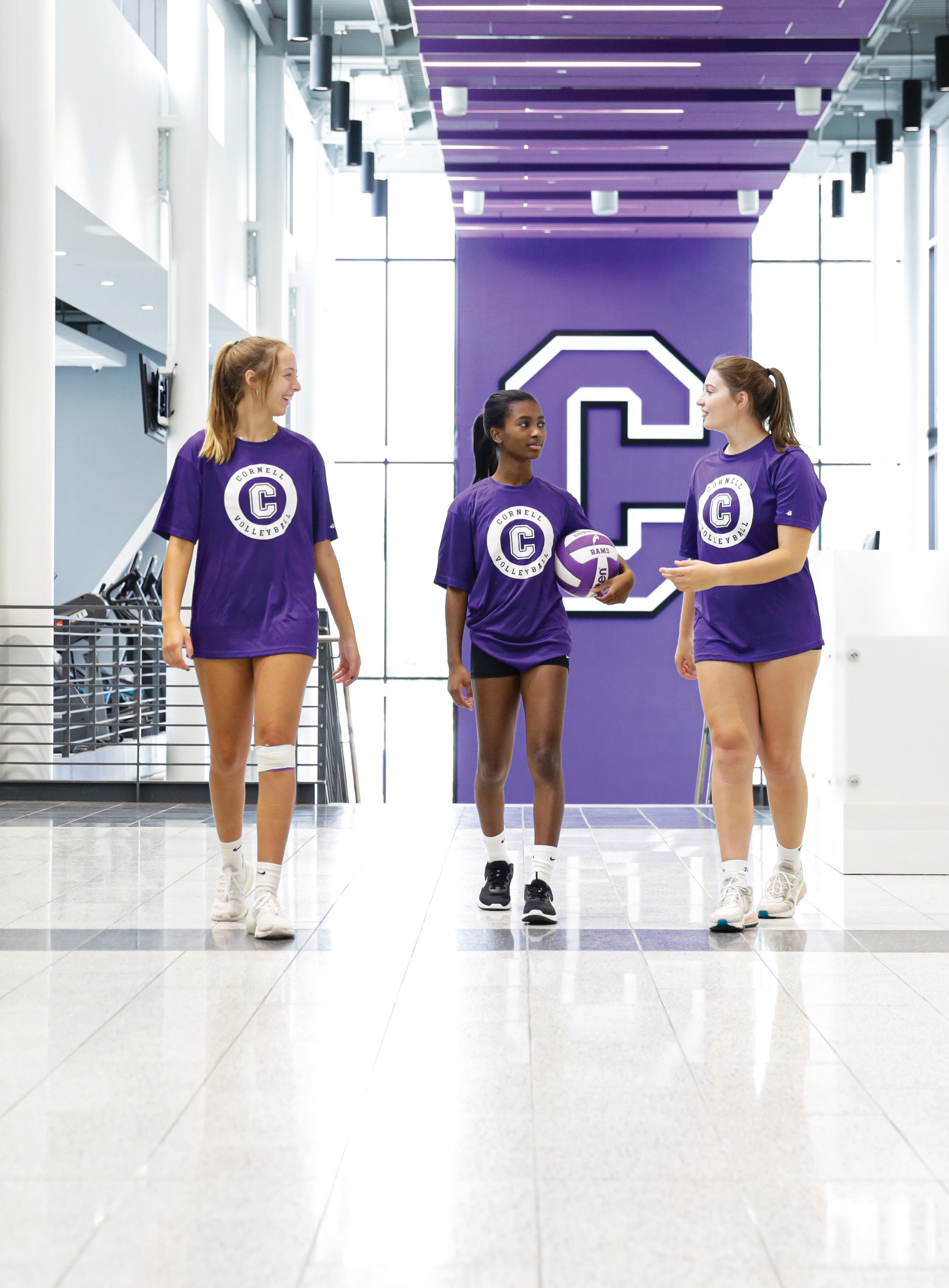
MEGAN AMR
19
Cornell began its 170th year this fall with more exceptional facilities, and more academic and student support, than ever before. And while we will continuously upgrade and evolve, Cornell, in fact, has never been greater than it is today.

The campaign focused resources on two priorities: facilities that support learning and well-being, and endowment growth that supports scholarships and a new core curriculum. On Aug. 31 Greater > Than came to a close as the largest fundraising campaign in Cornell’s history. Donations reached $118.6 million, far exceeding the initial $80 million goal.
Strolling through campus you can’t help but notice results.

The SAW (Richard and Norma Small Athletic and Wellness
“The SAW is something Norma and I are incredibly proud to have our names on,” said Richard Small ’50. “It will set Cornell apart and serve our students better than we ever have.”
continued on page 23 20
MEGAN AMR
Jonathan Azenon ’24 arrived on campus in the fall of 2020, during the pandemic. While many of his classmates were learning virtually from home or their residence hall rooms, he was in the new Russell Science Center much of the year working hands-on with his faculty.

“It was cool to see Russell Science be able to switch gears to make sure education was still happening during the pandemic,” Azenon said. “Even though we had to be six feet apart, the professors were able to work with us. That’s something I was super grateful for.”
Azenon has been using the new facility—part of the Greater > Than campaign’s $35 million Science Facilities Project—literally year-round. For the past two summers he has participated in the Cornell Summer Research Institute.
He came to Cornell from Culpeper, Virginia, intending to become a doctor. Then he discovered a new passion.
“Barbara Christie-Pope taught the intro biology course as a research project, and we got to develop a whole project. I decided to see if cinnamon could inhibit bacterial growth—and it did! After that I decided I wanted to keep doing this.”
That summer Assistant Professor of Biochemistry Catherine Volle and Associate Professor of Chemistry Jai Shanata ’05 invited him into their labs. That is when he fell in love with science, he says, “And Russell Science Center has been my home base since then.”
This year his research is taking him around the world.
During Block 2 he and Volle presented at an American Chemical Society conference. Block 3, Professor of Geology Rhawn Denniston sent him to a lab in Venice, Italy, to analyze stalagmites. He will present on that research at a conference in Chicago during Block 4. Finally, he’ll present with Volle again at a conference in San Diego Block 6.
He’s declared two majors: biochemistry and molecular biology, and French. When he’s not studying Azenon is a resident assistant at Pauley-Rorem, a chemistry tutor, the Diversity Committee student representative, International Student Services student manager, women’s soccer manager, and he works at Cole Library.
“It’s about taking advantage of these opportunities,” he said of his Cornell experience. “Cornell does its part helping students achieve their full potential. As you can see, I’ve done a lot in just two years, and I’ve got two more years to go.”
Azenon found home base in Russell Science
CINDY STRONG
Jonathan Azenon ’24 conducts chemistry research in Russell Science Center. He collaborates with three science faculty on their research.
“It’s about taking advantage of these opportunities. Cornell does its part helping students achieve their full potential.”
21 CORNELL REPORT | FALL 2022
Scholarship was life-changing for Barnard
Bailey Barnard ’21 grew up in the small town of Keystone, Iowa, with an older sister who enrolled at Cornell. With two in college at the same time, it was going to be a stretch for their parents. But when Barnard found out she would receive Cornell’s Mary Bowman Seidler Endowed Scholarship, she knew she would join her sister, Morgan Barnard ’20, on campus.
“Without the scholarship,” she said, “I don’t think I would have been able to attend Cornell.”
Much like Barnard, Mary Bowman Seidler ’61 grew up in small town Iowa—Mount Vernon, to be exact—and attended Cornell along with her twin brothers. She says scholarships also enabled the three of them to attend, and their Cornell educations set them up for success.
Seidler and her husband, Stanley, established their endowed scholarship as part of the Greater > Than campaign.
“I want to see as many others as possible have the opportunity we had and that’s why I decided to put this into action in my lifetime,” Seidler said. “What is more exciting in life than being able to nurture young people? That’s the best investment that one could possibly make.”
Both Barnard and Seidler are pioneers. Seidler worked at Harris Bank in Chicago as a vice president when it was a male-dominated field. Barnard’s academic interests sometimes found her as the only woman in a class, and now she also works in a male-dominated field.
Barnard graduated in three years with a degree in business analytics and a minor in applied statistics. During her second year on campus, Barnard and three other students competed in and won the novice division of the Midwest Undergraduate Data Analytics Competition.

Her internship with Goldman Sachs translated into a job at the global firm after graduation. Now she’s attending the Disney College Program in Orlando.
“Being able to attend Cornell helped me grow as a person and pave both my personal path and my career path,” Barnard said. “That wouldn’t have been possible without the Seidler Scholarship.”
MEGAN AMR
An endowed scholarship set up by Mary Bowman Seidler ’61 allowed Bailey Barnard ’21 to attend Cornell.
“What is more exciting in life than being able to nurture young people? That’s the best investment that one could possibly make.”
22
—Mary Bowman Seidler ’61
Center) opened in August, blending athletics and wellness into one facility for the entire campus.

Russell Science Center opened in 2018 as the first building built for the block. This contemporary facility has not only changed how chemistry and biology are taught on the block plan, it fosters community through its clustered offices and spacious lounges–offering some of the best views on campus. The Ped Mall now stretches to the east edge of campus to connect Russell Science along its path.
West Science Hall’s updates are so extensive it’s hard to recognize the original 1976 building inside its front doors. McLennan College Hall, built in 1857, retained its historic exterior while being modernized indoors with the addition
Engineering majors start using the 3D printers in the Peter Paul Luce Machining and Fabrication Lab in their first year. Engineering was added in 2015 and is already the third most popular major.
of technology and air conditioning. Much of Law Hall was renovated to fit the needs of kinesiology, Cornell’s second most popular major. And we restored King Chapel’s iconic clock tower with its 1882 Seth Thomas clock.
Launched with a $20 million gift
The Greater > Than campaign launched publicly on Valentine’s Day 2017 with confetti, streamers, and the largest outright gift in college history. Trustee Jean Russell ’65 gave $20 million, with $19 million of that going toward the $35 million Science Facilities Campaign.
Once Russell Science Center opened, renovations proceeded on West Science and Law Hall, nearly doubling Cornell’s STEM space to 100,000 square feet, with room to grow
continued on page 27 23 CORNELL REPORT | FALL 2022
CORNELL
COLLEGE
“Cornell has an excellent reputation for pre-med, and we gave our gift to make sure that legacy continues. Carole and I were excited to support the science facilities at Cornell,” said Trustee Jerry Ringer ’59 of his gift with honorary alumna Carole Ringer.

“Science moves very fast. This rapid increase in knowledge and technology makes it essential to continue to invest in the technologies in those fields. Barbara and I are working to make sure Cornell stays state-of-the-art,” said Ralph E. “Chris” Christoffersen ’59 of his gift with Barbara Christoffersen to establish a research lab in Russell Science Center.

ALLAN RECALDE 24
ROBYN SCHWAB AARON ’07
“What better way to drive home to students the importance of the mind-body connection—and the fact that physical fitness is the foundation for total wellness—than for the college to invest in this beautiful wellness center,” said Cornell Health Promotion Director Marcia Sisk.


AMR
MEGAN
25 CORNELL REPORT | FALL 2022
MEGAN AMR
Endowment takes students to New Zealand
In 2019 Professor of Geology Rhawn Denniston and 15 Cornell geology majors flew to New Zealand, where they spent a block hiking and drawing detailed geologic maps. They mapped out shifts in the Earth’s crust caused by a series of prehistoric earthquakes. They saw evidence of a late glacial advance far into the valley floor. They hiked all day to a mountain topped by ancient sea floor and chunks of Earth’s mantle. There was so much to
 RHAWN DENNISTON
Students in the Geology of New Zealand course draw geologic maps on the shore of Golden Bay.
RHAWN DENNISTON
Students in the Geology of New Zealand course draw geologic maps on the shore of Golden Bay.
26
“It was so special to complete my field experience with the geology majors I had spent four years studying with and growing close to.”
see that they took their final exam on the flight home.
The trip happened because of the LaFollette-Sitterly Geology Endowed Fund—established by Preston Sitterly ’69, Steve LaFollette ’69, and Steve’s wife Julie LaFollette. They created their fund in 2018 through the Greater > Than campaign.
Geology majors are required to participate in an extended field course, which is often a highlight of their education, but the rising costs of travel, and their inability to continue part-time jobs, can make participating in a field course a huge financial burden, Denniston says.
“In some cases in the past, students have opted not to pursue their interest in geology because of the expense of a field course. Now, thanks to extraordinarily generous gifts, the geology department has the capacity to defray the overwhelming majority of these costs,” he says.
Looking back, Kira Fish ’19 says the course was even more special than she realized at the time. As she talked with fellow geology graduate students at UCLA, she discovered that most colleges are unable to offer a field course like Cornell does, so students end up going to field camps with other college students across the country.
“After these conversations, I can confidently say that the Cornell field experience is truly unique,” Fish says. “It was so special to complete my field experience with the geology majors I had spent four years studying with and growing close to.”
To top it off, she says, the department made the trip affordable.
“These trips would be impossible without financial support from the geology department and its donors, and that is something I know we are all grateful for.”
as enrollment increases. Russell stepped forward to provide additional lead gifts totaling $12.5 million to the athletics and endowment components of Greater > Than.
“Through my giving I want to provide Cornell faculty and students greater tools and opportunities to thrive. And ultimately, I want to help Cornell grow and flourish,” she said.
As donor support broadened, the campaign grew to encompass other strategic initiatives.
Strengthening the financial foundation
Concurrent with the Greater > Than campaign, Cornell’s faculty were planning a new core curriculum, which launched in 2020. Named Ingenuity, it leverages the One Course At A Time academic calendar to make connections between the liberal arts and students’ future work through experiential learning opportunities. It requires students to have two Ingenuity In Action (hands-on) experiences. Cornell now provides more than $700,000 per year in direct student support for those activities.
Numerous new endowments support that funding, including the Stoll Program for Law & Society. Trustee Sheryl Atkinson Stoll ’70 and her late husband, honorary alumnus Bill Stoll, funded this program, which supports Ingenuity in Action opportunities such as Mock Trial.
“Our goal was to help students understand the real world of legal practice and the many different pathways open to them with a law degree. We believed in this so strongly that we wanted to endow the Program for Law & Society so it could grow and be self-sustaining for as long as possible,” she said.
The largest gift to Ingenuity in Action—a $4 million fund administered through the Greater Cedar Rapids Community Foundation—was given by John Smith ’71 and honorary alumna Dyan Smith
Recognizing that today’s college students and their families have become increasingly debt-averse, the college made it a priority to increase financial aid. Through endowment gifts the college was able to offer new named scholarships, as well as innovative scholarship and debt-reduction programs for students.
Donors contributed a total of $23.4 million to Cornell’s endowment, providing a perpetual resource for student financial assistance and academic support by establishing over 60 new endowed funds during the campaign.
27
Finance major finds her niche
Abby Patten ’23 is a finance major who wants to own her own business. She’s already had three courses in the new Don Cell Finance Lab, which simulates an investment trading floor with monitors and a stock ticker display that stretches around the ceiling displaying live market information.

The lab is a major feature of the renovated McLennan College Hall, a building which dates back to 1857—exactly 100 years before the debut of the S&P 500 stock index.
“In our Investments course we used the stock display quite a bit. Every morning we started out talking about where the market was that day, especially the S&P 500, and stocks like Tesla or Apple,” Patten says. “Even during class I noticed myself and my classmates looking up there and seeing what’s going on.”
Faculty use the ticker information in many ways, such as demonstrating a trend or explaining the impact of current news on asset values. It underscores the importance of keeping abreast of the market, a habit essential in finance careers.
Patten enjoys the lab so much that she and her classmates gravitate there during breaks and downtime when they’re in the building, she says. When she isn’t studying in Cole Library, she likes to study in the lab, named for the late Professor Emeritus of Economics and Business Don Cell and funded by Dick Chambers ’65. He and other donors invested a total of $3.6 million in McLennan College Hall, with a generous lead gift from Bob McLennan ’65 and Becky Martin McLennan ’64
Patten captains the Cornell cheer team, serves on the Student Athlete Advisory Committee, and participates in Lunch Buddies with third graders at Mount Vernon’s elementary school—where she once was a third grader with her own Cornell Lunch Buddy. She holds two part-time jobs and coaches cheer at Mount Vernon High School.
Cornell recently established a partnership with Iowa State University’s graduate finance program, and Patten says she may pursue that program when she graduates after only three years.
”I don’t want to leave Iowa,” she says. “I love being here.”
Abby Patten ’23 stands in the Don Cell Finance Lab, which simulates an investment trading floor within McLennan College Hall.
“In our Investments course we used the stock display quite a bit. Every morning we started out talking about where the market was that day.”
28
MEGAN AMR
“We hope that the updating of College Hall will have a positive impact on students, particularly prospective students, and because almost one-third of the faculty have their offices in the building, we hope it will underscore how much they are appreciated,” said Bob McLennan ’65 of the lead gift he and Becky Martin McLennan ’64 made to the $3.6 million project.
The SAW opens
As students arrived this fall they were welcomed into the new SAW. Built around the core of the 1953 Field House and 1986 arena addition, the facility was expanded and transformed into a wellness and athletics center that serves our athletics teams, along with our entire student body, faculty, and staff.
The spacious lobby is a place where students, faculty, staff, visiting teams, and spectators can sit, relax, and just enjoy the building—or view the competition through windows into the gym. New spaces for cardio-fitness, locker rooms, athletic training, group exercise, coaches’ offices, and conference rooms meet the needs of Division III student-athletes and the college’s Well-being Network, which prioritizes the
mental and physical well being of our students.
“Having a state-of-the-art facility like this contributes to the health and wellness of all students,” said Scott Ririe ’79, a lead donor to the $20.5 million project with his wife, Shelley. “I love that it is also a recruiting tool to attract more student-athletes to Cornell. And, it creates a welcoming environment where students will have meaningful experiences.”
Joining the Riries as lead donors were Jean Russell ’65 and Richard Small ’50 and his wife, honorary alumna and Trustee Norma Thomas Small. The Hall-Perrine Foundation, a long-standing supporter of Cornell, provided significant support to both the Athletics and Wellness Facilities Project and the Science Facilities Project with challenge matches.
 ROBYN SCHWAB AARON ’07
ROBYN SCHWAB AARON ’07
29 CORNELL REPORT | FALL 2022
“That piercing tower in the sky is iconic. We want to protect that forever for Cornell,” said Trustee Linda Webb Koehn ’66 of the lead gift she and her husband, honorary alumnus Thomas K. Koehn, gave to restore King Chapel’s clock tower and 1882 clock.

What we accomplished together
Planning and running a campaign takes years of work, and Board of Trustees Chair Jeff Jensen ’81 found the process rewarding because of the donors.
“It has been a pleasure to be part of this campaign, to see how deeply so many people care about this institution,” Jensen said. “They believed in our dream and gave generously, making Cornell an even greater place for our students now and far into the future.”
As President Jonathan Brand announced at the outset of the campaign, Cornell is an ambitious and motivated school, and this campaign was created to realize those ambitions. A community of over 9,000 donors contributed to the Greater > Than campaign, and together they have elevated Cornell.
Our facilities improvements are having a direct effect on recruitment and retention. Our wellness center is positively impacting students’ mental health. Our endowment growth provides stability. All of this leads to increased enrollment and retention that further enhance the college’s financial strength—continuing to ensure that students have opportunities to gain a broad and deep Cornell education.
“Thanks to our generous donors, the college is in a much stronger position to meet the challenges of the coming years,” Brand said. “The campaign and our donors allowed us to accelerate our progress and move forward with vigor. Cornell deserves every success that it has. Cornell, Greater Be Thy Name.”
30
ROBYN SCHWAB AARON ’07
JEFFREY M c CUNE ’99
A scholar who teaches disobedience
Jeffrey McCune ’99 is an extensively published writer, professor, and higher ed administrator with an impressive bio. He’s also Black and queer, a self-described “hard optimist,” a lyrical orator even in casual conversation, and a professional speaker. He brings energy into conversations that would wake up the sleepiest undergrad.
As the director of the Frederick Douglass Institute (FDI), McCune organized and galvanized a community of scholars at the University of Rochester in his first year to move the program of African and African American Studies into what is to be the Department of Black Studies.

“And Black here is to encompass and represent and name the African diaspora plurally,” McCune says, “so it is not just about African Americans but African Caribbeans, European Africans, Africans, and people who live all over the globe who use the term Black.”
FDI started in 1986. McCune completed a post-doctoral fellowship year at FDI in 2006-07, and his new charge as he returned to FDI a year ago was to advance the original mission while developing an infrastructure that was both enlivening and sustainable. Previously, McCune was on faculty at Washington University in St. Louis.
His advice to Cornell students is to never forget the mission here on Earth is never to advance oppression, but to advance freedom for all. Hence, he says, this is why all must first recognize the importance of the study of Blackness, especially in a world with disproportionate rates of class inequality, joblessness, and homelessness among Black and brown folks that occur at alarming rates; where we see COVID ravaging Black and brown communities especially, and where we see anti-Black state violence.
“Truly, I believe Du Bois is still right; the problem of the century is still race. I would encourage current Cornell students and alumni to take seriously these questions of race—and pursue them with rigor,” McCune says. “The questions of race are not just how to not be racist, but to understand how we exist in the world in which we live. What is our role as people of all races? We organize ourselves, sadly, against what we are not. That advances anti-Blackness that has historically been a part of this country.”
The real measurement of the health of our country, McCune says, is how those who are at the bottom are doing. Grotesque individualism is what has infringed on the rights of so many; it’s killing us, he says.
McCune’s pitch is that we fail better at what we’ve learned about our world; that it goes beyond unlearning white supremacy, sexist notions, homophobic reactions, and distrust of another’s religion. Instead. he says we must disobey the dictates of what we’ve absorbed from our culture and history.
“Today, across the cities of the world, we see a tradition of young Black men communing on the corner. We know that, historically, young Black men on the corner are harassed,” he says. “In a failing white supremacist world, we will just say ‘hello.’ For today, we will not stare as we drive by them. If we are failing better, we will not police them. Today, we will see them with care for their humanity; we will not kill them.”
—LISA GRAY GIURATO
Read more about McCune and his work at crnl.co/mccune
Watch McCune being interviewed about his work with the FDI at crnl.co/fdi
WEB EXTRA
“The questions of race are not just how to not be racist, but to understand how we exist in the world in which we live. What is our role as people of all races?”
J. ADAM FENSTER/UNIVERSITY OF ROCHESTER
31 LIFE AFTER CORNELL
18 things
to love about Cornell
By Dee Ann Rexroat ’82 & Lisa Gray Giurato
Most Cornell alumni first moved onto campus at the age of 18, the age when you became a legal adult. To chemists 18 is the atomic number of argon. There are 18 holes on a regulation golf course, 18 players in Australian football, and in some cultures, 18 is considered a lucky number, the numerical equivalent of life itself.
And here at Cornell, we know that students can do anything in 18 days, the perfect number of days in a block.
EVERYONE’S CORNELL EXPERIENCE IS A LITTLE DIFFERENT, AND SOME OF OUR FAVORITE THINGS ARE NOT UNIQUE TO THE HILLTOP BUT ARE NO LESS SPECIAL TO US. ALTHOUGH IT WAS TOUGH TO NARROW ALL THE THINGS WE LOVE ABOUT CORNELL TO ONLY 18, WE DID OUR BEST.
1The deep immersion of ONE COURSE AT A TIME. And the way it gives Cornellians the ability to focus in an age of distractions.
Cornell roomates Alice Ritter ’74, Linda Chin ’74, Maren Hansen ’74, and Marcia Radosevich ’74 (from left) gathered for a “playdate” in Santa Barbara, California, in 2017.

2Having classmates become your FRIENDS FOR LIFE Bonds forged during milestone moments stay steady despite time and distance. Reuniting with lifelong friends conjures happy memories and creates new ones.
 MAREN HANSEN ’74
Professor of Geology Emily Walsh and her students study rock specimens—in and out of the classroom—without distraction from other courses.
MAREN HANSEN ’74
Professor of Geology Emily Walsh and her students study rock specimens—in and out of the classroom—without distraction from other courses.
33
ROBYN SCHWAB AARON ’07
AFFINITY SEATING. The tradition of sitting next to friends instead of in alphabetical order at Commencement began with the Class of 1973 and will observe its 50th anniversary with the Class of 2023.

BLOCK BREAKS. For relaxing and road trips and athletics competition and pure fun. You will wish you could incorporate them into your career and life once you leave the Hilltop.
The beauty of the HISTORICAL BUILDINGS on and around campus, in any season. There’s a reason Cornell College was the first campus named in its entirety to the National Register of Historic Places.


5
4 3
Allee Chapel in springtime.
Friends Abdulla Awaji ’22 (left) and Aria Dehshid ’22 prepare to walk across the commencement stage. ALLAN RECALDE
ALLAN RECALDE
34
Block breaks can be a time to kick back like these students did one winter’s day.
THE ORANGE CARPET. Situated in the center of the Thomas Commons and visible from two levels, this expanse of warm orange tones has been a meeting space and hangout for students since 1966.
James Tutson and the Rollback (featuring Professor of History and German Studies Tyler Carrington on drums) performs on the OC in 2022 to a happy crowd of dancing students.

THE ROCK. Cornellians since 1889 share a campus boulder that is a message board, a selfie station, and a challenge to move, burn, and bury.

7 6
NICK SCHWARTZ
’25
Julissa Rivera ’24 paints The Rock purple, of course, after it was moved next to Law Hall in summer 2022.
35 CORNELL REPORT | FALL 2022
DEE ANN REXROAT ’82
THE PED MALL, a place to see and say hi to everyone. As Cornell’s campus grew, it’s Hilltop walkway came to offer more than a view of the Cedar River Valley. Almost everyone walks it daily to friendly Midwestern hellos.


The Ped Mall was replaced and upgraded in 2002, when it officially became known as the Marie Fletcher Carter Pedestrian Mall.
THE FACULTY AND STAFF. The Cornell experience “is about the community as a whole and how those experiences shape our lives,” says Tabitha Snyder Abels ’96, who has maintained a 30-year relationship with her facilities work-study supervisor, Gerry Decious.
10KING CHAPEL. A National Register icon. The touchstone of generations of Cornellians. The first sign of campus you see as you approach Mount Vernon, making your heart beat a little bit faster.

9 8
Professor of Economics and Business A’amer Farooqi warmly greets Abubakar Shehu ’17, an international student from Nigeria, following Commencement.
JACOB LUPLOW ’16
MEGAN AMR
’07
ROBYN SCHWAB AARON
Students and faculty in the 2019 Economics and Business 321 course jump for joy in China.

12A PRESIDENT who gets to know students by name. Current students like to highfive President Brand, who makes a point to get to know students by attending their sports, fine arts, and academic events. Other presidents have had similar devotion to Cornell students, often hosting student events in their campus residence.


President Brand high-fives
OFF-CAMPUS COURSES with Cornell professors. Spending a block with your professor and classmates to learn the subject matter of your course earns you credit, of course, but you also benefit from long-lasting relationships with your professor and fellow block-mates.
King Chapel dominates the campus skyline.
ALLAN RECALDE
Shelby Williams ’21 at a track meet on campus.
11
37 CORNELL REPORT | FALL 2022
TODD KNOOP
A rich history of CIVIL RIGHTS AND SOCIAL JUSTICE ACTIVISTS. Among the luminaries: Susan B. Anthony (1879), Booker T. Washington (1900), W.E.B. Du Bois (1905), Martin Luther King Jr. (1962), Julian Bond (1969), Shirley Chisholm (1982), Dick Gregory (1972), Jesse Jackson (1988), Gloria Steinem (1999), Cornel West (2001), The Rev. Raphael Warnock (2008), and Dolores Huerta (2001 and 2012).

RESIDENTIAL LIFE on the Hilltop. With 92% of students living on campus and calling it home, they know each other and care as a community. Plus there’s always someone to talk to down the hall.

13 14
Dolores Huerta, co-founder of the United Farm Workers of America, speaks in Kimmel Theatre in 2012.
CORNELL COLLEGE
Friends build a puzzle during a cozy afternoon in the residence halls.
38
MEGAN AMR
THE SQUIRRELS. They may not be unique to Cornell, but our squirrels—a.k.a. Cornell Chunkies—are an endearing aspect of campus life.

INK POND. A place of serenity where you can watch the water, the goslings, or the night stars and dream your big dreams or simply daydream the day away.

16
15
MEGAN AMR
Canadian Geese swim in Ink Pond with Cole Library in the background.
CORNELL COLLEGE
It’s a good day on campus when you come face-to-face with a curious squirrel.
OUR RIVALRY WITH COE COLLEGE. It began in 1891 and is the oldest football rivalry west of the Mississippi. It inspired the toilet paper toss and the all-sport Bremner Cup traveling trophy. And it connects three centuries of fanatical fans.

The legacy and power of the FINE ARTS at Cornell. The literary arts, music, theatre, dance, and visual arts are an enduring aspect of the liberal arts experience that continues to transport the artists and those who enjoy watching and listening.
WHAT DO YOU LOVE ABOUT CORNELL? Share with us at cornellreport@cornellcollege. edu

18 17
ALLAN RECALDE
A student production of “Rent” in 2018.
Early evidence of the rivalry with Coe from Altoona Hall, a former residence hall.
40
CORNELL COLLEGE ARCHIVES
HIROMI NAKAZAWA ’01
Facing big challenges
Hiromi Nakazawa ’01 lives with her husband Harper Reed ’01 and their young son in Chicago. She works as a tax senior manager at the global accounting firm Deloitte. Nakazawa grew up in the Yamanashi Prefecture in Japan, a sister state to Iowa, a connection that led to a scholarship funding her dream: living abroad and learning a new culture.
Her tight-knit family fretted over the idea of Nakazawa traveling so far from home, and she felt some trepidation about living in the Midwest. She soon learned it gave her opportunities: to learn about a new culture, meet new people, and understand Japan’s history better.
“I’m glad I came to Cornell,” she says. “The beautiful part of Midwest culture is that people are loyal, even if they are shy. I found them to be curious about people from outside their culture.”
Two years after transferring to Cornell, Nakazawa graduated with a bachelor’s degree in art with a focus on art history and a minor in anthropology; she went on to earn her master’s in art history from the Art Institute of Chicago.
She entered her industry in part because she wanted to use her bilingual skills and because she was interested in working with a group of multicultural women that she has now worked with at two different companies.
In Nakazawa’s work, she supports multinational companies that send and receive people from all over the globe. Her work makes sure companies and assignees are tax compliant, take the most tax-efficient positions, and that the host country and home country tax policies are met.

Nakazawa has faced many challenges, including when she was at
Cornell.
Professor of Art History Chris PennGoetsch supported Nakazawa in her academic endeavors when she most needed someone in her corner to cheer her on. When she struggled, PennGoetsch was there for her.
“Chris was my hero and still is my hero.”
Being an international student is not easy.
Reading large volumes of her non-native language as a student could take copious amounts of her study time, a challenge her native English-speaking peers did not face. She reached out to Anthropology Professor Alfrieta Monagan to ask her which readings were really important. Monagan helped her prioritize.
“When I was on the West Coast in the U.S. there was a greater Asian community,” she says. “But in Iowa, that wasn’t the case. People could not differentiate between where I was from and someone who was from another Asian country.”
But Nakazawa’s toughest challenge to date is also her proudest moment.
“I struggled with fertility. We used surrogacy,” she says. “I am proud that I accepted the fact that it doesn’t matter how we started our family. I used to be secretive and ashamed of it, but after my son arrived, it didn’t matter. I love him so much. Now, I feel there is a reason why I have done all I’ve done and that is to get ready for him.”
Nakazawa stays in touch with her friends from Cornell and values those friendships. She knows they are always there for her. And she is amazed at times, at how two years at Cornell had such a deep impact on her life.
—LISA GRAY GIURATO
IVAN INDRAUTAMA
“I’m glad I came to Cornell,” she says. “The beautiful part of Midwest culture is that people are loyal, even if they are shy. I found them to be curious about people from outside their culture.”
41 LIFE AFTER CORNELL
Alumni News
Help us identify the people with Martin Luther King on campus 60 years ago in 1962. Email us at cornellreport@ cornellcollege.edu

From left: Unidentified woman, unidentified man (in profile), Dave Knutson ’64, Millie Eubanks Carstensen ’66, Carolyn Chamberlain Lynner ’66, Jean McNeilly Balster ‘42, Craig Kuehl ’66, unidentified woman.

42 ALUMNI NEWS
1963 ROYAL PURPLE
CORNELL COLLEGE ARCHIVES
From left, possibly Susan Chapman Linden ’66, Professor of Art Vivian Heywood, Tom Kingston ’66, unidentified person, possibly Ernie Norris ’63, unidentified person, Jean McNeilly Balster ‘42, unidentified seated woman, unidentified woman.
1940s
Betty Olmsted Bayles ’46, Harpursville, New York, moved 1.5 miles from her farm, closer to town, to a home where the owner takes care of four to five “older” ladies. Betty’s older daughter lives a mile away; her son Tom Bayles ’73 is in Pennsylvania; and her younger daughter is in North Carolina. She enjoys her nine grandchildren and nine greatgrands when they visit.
Don Kent ’46, Grand Mound, Iowa, left his home of 64 years to move to an assisted living facility last summer.
1950s
The best thing that happened this year to Lurene Noland ’54, of Nashville, Tennessee, is that “I was allowed to go on a violin concert tour to Italy with my grandchild, her parents, and her classmates in Suzuki learning.” They performed in Rome, Florence, Pisa, and Venice. She reports that it was extremely hot, and they walked and walked, but all the young ones were kind and helpful to her. After 10 days her family went to Paris so Lurene could be there “one more time.”
Lurene says: “The contrast in the sounds of Italy with the sounds of France was beautiful. If I, a member of the class of ’54, can do it, so can you!”
HelenSue Lewis Parrish ’56 and her husband, Bill, celebrated their 50th wedding anniversary in June in Starkville, Mississippi, where they had lived for 44 years. They were married in St. Mary Aldermanbury Church on the Westminster College campus in Fulton, Missouri, where Bill taught American History for 24 years. They moved to Starkville in 1978 when he became head of the Mississippi State history department and continued teaching there for
25 years. HelenSue was the city goodwill hostess and welcomed newcomers for 17 years. She organized a Newcomers Club which continues today. They recently moved to Country Meadows, an assisted living facility in York, Pennsylvania, to be closer to family.
Jan Linsey Rudzik ’56 and her husband still live in their home in Glendora, California, where they are busy donating clothing and other items they no longer want to keep. She keeps in touch with Barbara Klein Johnson ’56, Beulah (Boo) Newton Erickson ’56, Nadine Fortna Tope ’56, Phyllis Hogle Newton ’57, Phyllis McCannon Townsend ’55, Chuck Price ’57, and Marge Heitman Price ’59. “We all recognize that we can now be called ‘elderly’ and have a lot in common: mainly, we are all still alive so we can celebrate that fact.”
Ken McKinley ’57, Kirkwood, Missouri, has been widowed twice. Ken still plays golf twice a week, and he’s surrounded by a son and four daughters.
Dan Kellams ’58 and Wally Dewoody ’58—who were sports teammates at Marion High School in Iowa—have been elected to their school’s athletic hall of fame. Wally was a threesport athlete who received all-state honorable mentions as a football quarterback and as his basketball team’s top scorer. In track, he ran on two relay teams that won conference and district championships. Dan was honored principally for his biography of a legendary Marion coach whose strict rules helped guide his football, basketball, track, and cross-country teams to 33 state and conference championships. The book, “A Coach’s Life: Les Hipple and the Marion Indians,” published in 2010, also chronicles changes in society and the town that contributed to the coach’s downfall. Dan played four sports under Hipple. Wally and
Dan were elected honorary basketball co-captains as seniors. Wally died in 2008. Dan and his wife, Elaine, live in Sun City, Arizona.
1960s
Larry Mitchell ’60, Ames, Iowa, lost his wife, Sara, on Jan. 30, 2022. This past summer he spent a month in Germany and England. He was with his daughter in Halle, Leipzig, Dresden, Wartburg Castle, and Munich, Germany. On his way home he was in England, where his son-in-law hosted him at Wimbledon.
Following the death of his wife, Christy Kramer Rhoads ’60, in 2019, Donald Rhoads ’60 has lived in Atria Senior Living in Falmouth, Massachusetts. He reports that he met a wonderful widow there, and they now share an apartment. He is busy writing his professional memoir for Yale University’s Sterling Memorial Library archives. Since he can’t drive anymore, he’s selling his classic car collection.
The best thing that happened in 2022 to Barbara Gerhard Jones ’64, of Pittsburgh, Pennsylvania, is that she went to southern France for an entire month and immersed herself in the landscape, language, and village life. “A good friend of mine and I rented an apartment in a farmhouse in Provence. My husband chose to stay home where the challenges were fewer, but fewer wonderful surprises happened. People were generous, kind, and forthcoming with us. It was fun!”
In early 2022, after 55 years in or near Boulder, Colorado, Kay Wilkinson Norris ’64 and her husband moved to a retirement community in Lake Oswego, Oregon. They are slowly adjusting to the lack of house and yard maintenance and enjoy being near their two daughters.
CONTRIBUTE
We love receiving updates. Submit your news to crnl.co/classnews
43 CORNELL REPORT | FALL 2022
The best thing that happened to Lurene Noland ’54 this year is that “I was allowed to go on a violin concert tour to Italy with my grandchild, her parents, and her classmates in Suzuki learning … If I, a member of the class of ’54, can do it, so can you!”
Donald Patterson ’64, Brooklyn, New York, originated and conducts weekly poetry seminars by conference phone to various budding poets in Bloomfield, New Jersey. One member, Samantha Samakande, has had several of her poems published in literary journals. The effort is in memory of the late poet and Cornell Professor Robert P. Dana.
Helen Blue Holder ’65, Austin, Minnesota, is in the final production steps for two more children’s books she’s written and illustrated. She’s been out to book fairs and bookstores selling and signing her other seven books.
CORRECTION: An update from Phil Gibbs ’66 was included in the Robert Reimers ’66 class note in the summer issue. Here are the corrected versions:
Phil Gibbs ’66, Levittown, Pennsylvania, writes that he’ll be retiring from his business in the next year and plans to do some traveling and “do a lot of vegging.” His son, Alex, is a priest attending Pontifical Gregorian University in Rome for his Ph.D.
Bob Reimers ’66, Houston, Texas, spent 40 years at Tulane’s School of Public Health and Tropical Medicine, retiring in 2015 as professor emeritus of sustainable resource management. He is an adjunct professor at Texas A&M University (College Station, Texas), adjunct professor at LSU School of Public Health (New Orleans, Louisiana), and affiliate professor at Concordia University (Montreal, Quebec, Canada). He and David Schnare ’70, retired policy scientist and attorney with the U.S. Environmental Protection Agency, formed a company that manufactures a product to
disinfect and sterilize infective microbes (including those causing COVID-19, monkeypox virus, and antibiotic-resistant microbes) in hospitals, schools, and healthcare facilities. Bob and his colleagues have published three articles on Ebola and coronavirus in the last year.
Peter King ’66, Lake Geneva, Wisconsin, is semi-retired from his law practice and serves as a municipal judge. He and his wife have two grandchildren and a third on the way. One daughter and her family have their home in Minneapolis and the other daughter and her family have a home in The Netherlands, where they visited in April. On weekends he serves as a principal race officer for the Lake Geneva Yacht Club, usually running races for four fleets simultaneously.
Craig Kuehl ’66, New York, New York, and his wife, Jane Lucas, celebrated their 50th wedding anniversary in Venice last fall. The weather was perfect and the tourists were few during their third visit there. Last spring they spent six weeks in “their” secret village in Provence, followed by 10 days in Geneva, where they had lived for eight years. Hint: Compared with New York, France is cheap, and Geneva was extraordinarily expensive.
Since being back in Iowa for almost 20 years, Anita Bill Shekinah ’66, West Des Moines, Iowa, has facilitated classes through her business, the Shekinah Life Purpose Center. After a slowdown during the pandemic, she offered Creating a World Worth Living: Reinventing Our Lives After COVID. “Through this crisis we have come to learn what is really important (and what isn’t),” she writes.
In February Ingrid Wendt ’66, Eugene, Oregon, taught a class in poetry writing to upper grade Spanish- and Mayan-speaking students in an after-school program in Akumal, Mexico. It’s the place she and her late husband, Ralph Salisbury, used to call their heart’s second home. Some of her recent poetry publications appear in print journals and online, including Poetry, American Poetry Review, Terrain, About Place, and Cutbank, in which her poem was a finalist in a national contest. Find them at ingridwendt.com.
Paul Lubenkov III ’67, La Grange, Illinois, retired from his teaching position at Morton College and now serves as his wife Terry Anne’s full-time gardener. “I manage to steal time to write, and my work was recently accepted and published in The Journal of Undiscovered Poets.”
The Truck Renting and Leasing Association recently honored Thomas Brown ’68, Bonita Springs, Florida, who is CEO of Urbandale (Iowa)-based Brown NationaLease, with the Steve Lawrence Legacy Award. TRALA’s membership includes nearly 500 leasing and rental firms and 100 suppliers that make up nearly the entire U.S. truck renting and leasing industry. Brown has served on the board of directors of TRALA for more than 25 years, including two terms as chairman, as well as treasurer. Brown has held leadership roles in the family-owned company for 53 years; his father founded the company in 1940. In addition to truck leasing, the Brown family expanded into multiple companies in the trucking, logistics, and warehouse business.
Jack Carbee ’68, Marseillan, France, published his second novel based on Dante’s Divine Comedy, “Escape from the Inferno.” His two collections of short stories— “Morning Wine” and “Thinking, Just Thinking”—and the novel “Trapped in the Inferno” are available on Amazon. Jack, who is single, lives in a village on the
Mediterranean. While in the U.S. visiting his four children, Jack gave a reading and signed books at the Lisbon Library.
Carol Shiner Wilson ’68, Bethlehem, Pennsylvania, marked the first anniversary of her husband Dan’s death by participating in a room-naming event at the Lehigh Valley Center for Independent Living. Dan’s service on the LVCIL board included two terms as president. The dedication was touching and low-key.
Although he retired from law practice in 2017, Keith Collins ’69, Cedar Rapids, Iowa, reinstated his license in December 2021 to cover the practice of his first law partner in Belle Plaine, Iowa, during that partner’s recovery from heart surgery. He commuted from Cedar Rapids instead of returning to his winter home in Pullman, Washington. The two homes allow them to share in the lives of grandchildren in Pullman and Oelwein, Iowa. Part of his retirement has been spent in translating the Bertolt Brecht plays “Leben des Galilei” (“Life of Galilei”) and “Mutter Courage und ihre Kinder” (“Mother Courage and her Children”) into English from the German. “I selected these plays because of the stillburning issues we face today of attacks on science and the crazy ironies inherent in war. Of course, I want to make full use of my Cornell German major and learn more about Brecht, who fled Nazi Germany only to be grilled by hostile members of Congress for allegedly being unAmerican, ie: socialist. By the way, I saw ‘Mother Courage’ my freshman year at Cornell and that production still has a long reach inside my psyche.”
Steven Greenfield ’69 and Mary McComb Greenfield ’68, Baldwin, New York, survived the COVID years with long walks and volunteer work on Long Island. “The most meaningful activity is working at a soup kitchen and food pantry every Friday for the past two years,” he writes. They toured Costa Rica and Alaska this year.
44 ALUMNI NEWS
Paul Lubenkov III ’67 retired from his teaching position at Morton College and now serves as his wife Terry Anne’s full-time gardener.
1970s
Dennis Cress ’71, Iowa City, Iowa, reports that his children want him and his wife, Charlotte, to retire and become sedentary. “Fortunately, it is not among our plans to keep working until we are no longer wanted or needed. It would be nice to see more of our 13 grandchildren, but we can do that with sufficient preplanning. Perhaps, in the next couple years, we will decide to retire.”
Timothy Hamilton ’74, St. Louis, Missouri, had a solo painting exhibition at the Cathy Gregory Studio Gallery in St. Louis in April 2022. He traveled in 2019 to China and Italy with his wife, Grace.

Marta Wherry Mathatas ’74, Wooster, Ohio, reports she was so glad to see Marilyn Maether Copeland ’74, Alan Copeland ’74, and family in
Libertyville, Illinois, in early June. “Our oldest children were born just three months apart, and it was great to see these kids all grown up.”
Robert Nellis ’75, Rochester, Minnesota, retired from Mayo Clinic on Aug. 31 after 19 years. He made his return to Heart Mountain, Wyoming, for the Heart Mountain Pilgrimage and groundbreaking for a new educational center. The site was one of a dozen incarceration camps housing Japanese-American citizens and their non-citizen parents during WWII—and the subject of a documentary he helped produce over three decades ago. He and his wife, Pam, were awaiting the arrival of their second grandchild, as of his writing, and visiting their first grandson in Chicago. They have four children.
Nancy Parmeter Stewart ’76 is in the process of retiring from GracePoint Wesleyan Church in Brookings, South Dakota, after
25 years as finance manager. She has been involved for 30 years with children’s ministry, which included mission trips to Alaska and Russia to help with vacation Bible schools. Her husband died a couple of years ago, and her daughter and her family live nearby. Nancy loves spending time with her grandchildren. She also planted her first garden and looked forward to harvesting her own vegetables.
Michael Lawler ’77, Coralville, Iowa, retired in 2021 after 41 years as a certified athletic trainer—seven years at North Brunswick Township High School in New Jersey and 34 at the University of Iowa. Now he enjoys working in his yard, on house projects, building his HO model railroad layout, and riding his road bike. He has ridden on 11 RAGBRAIs (The Register’s Annual Great Bike Ride Across Iowa) and has been the leader of the Cornell College Team RamBRAI group for nine years. “Now that my Saturdays
Learn more and apply to be considered for the Cornell Alumni Association Board of Directors today at crnl.co/nominate
45
We are seeking alumni who share our vision for an Alumni Board that welcomes and embraces differing backgrounds and perspectives.
Tracy Curtright Reinhard ’82 retired after 39 years and is leaving music education behind. She taught K-12 and was an instructional coach for 50 music prep teachers, worked at 10 school districts, 18 schools, 25 principals and one supervisor, and 22 classrooms including a closet, a hallway, a gymnasium stage, a trailer, a chemistry lab, and under a tree.
are free, I hope to attend more Cornell Homecomings and athletic events. I was especially honored to be highlighted in the spring Cornell Report. I enjoyed sharing my story, especially about my time at Cornell College.”
Dan Morse ’77, Madison, Wisconsin, writes that as he celebrates his 67th birthday he is reflecting on the positive things in his life: “Great wife, family, and friends. Since last year, we have another grandchild, with one more on the way this year. That brings a total of eight.” His summer was busy with trips to northern Wisconsin and a wedding. He’s looking forward to the annual fall Milt retreat at the Iowa farm of Karl Kost ’77: “Lots of fun and debauchery. Well, at least the fun.”
After 37 years on the Penn State faculty, Richard Carlson ’78, State College, Pennsylvania, has retired. His wife also retired and they are going to take some time now to read, listen to music, watch movies, and do a bit of traveling as it feels safe. “I’ll keep an office on campus for a while, serve on grad student committees, and do some editorial work. It will be nice to work in the garden on nature’s schedule too.”
Harley Newell ’78, Minneapolis, Minnesota, rocked out at the Coldplay concert with his two Chicago daughters. He spent the afternoon with Gordy Hellwig ’78 checking out the Cezanne exhibit and geeked out watching a wrecking ball doing its thing to a building in Chicago’s old meatpacking district. He even made it past the Chicago Midway TSA agents with his precious cargo of Paulina Meat Market jerky. Otherwise, he’s hanging with friends on the golf course, taking midday lake cruises, and working on a kids’ book with another Cornellian who is creating the illustrations. “Hot time, it’s summer in the city ... sidewalks are hotter than a match head. Chilling with my grandkids … Every day is Saturday and loving life to the max.”
Jerry Worsham II ’78, Cave Creek, Arizona, joined a few Hobbs (New Mexico) high school friends to climb Guadalupe Peak, the tallest in Texas—an 8.5-mile round trip hike that took 7.5 hours. “Hopefully things are going well with the new athletic facility to really improve the students’ experience and the athletic program!”
Louis Thompson ’79, Flossmoor, Illinois, retired after 40 years of pharmacy practice, and now enjoys golf, playing jazz trumpet, building credit spreads, and travel, in no particular order.
1980s
Dana Dahl Touzelet ’81, Les Paccots, Switzerland, retired as vice president, global ethics and compliance, from Edwards Lifesciences after 14 rewarding years of service. “Chris—who retired at the end of last year—and I are looking very forward to continuing to travel the world, but on a far more leisurely timetable! We’ve called Switzerland home for 15 years now, and plan to stay.”
Tracy Curtright Reinhard ’82, Ogden, Utah, retired after 39 years and is leaving music education behind. She taught K-12 and was an instructional coach for 50 music prep teachers, worked at 10 school districts and 18 schools, under 25 principals and one supervisor, and in 22 classrooms including a closet, a hallway, a gymnasium stage, a trailer, a chemistry lab, and under a tree. She received teaching certificates in Colorado, Texas, and Utah, was certified in K-12 music education and earned her highest degree, a master’s in arts curriculum instruction. Her next venture is health coaching. Tracy lost 137 pounds in the past year and coached over 50 clients.
George Krivo ’84, Haymarket, Virginia, is managing director and senior operating executive—head of defense and aerospace at Cerberus Operations and Advisory Company, LLC.
Charlie Kuester ’84, Iowa City, Iowa, and his brother, Steve, completed a road trip to the Arctic Ocean. While they had hoped to camp more, the mosquitoes drove them into hotels and hostels after two nights. The sun never set on them as they got north of the Arctic Circle, and they saw snow-capped mountains, bison, black and brown bears, and bighorn sheep. The drive up was 3,981 miles, the last 600 on gravel—and then they retraced their steps back to Iowa.
Michelle Krezek ’85, Boulder, Colorado, retired in May after almost 20 years as chief of staff to the Board of County Commissioners in Boulder County. She and her partner Tommy plan to spend the summer of 2023 on the road in Alaska in their Ford Transit campervan. She and the Cornell Gal Pals have been getting together at least once a year for years and recently met in North Carolina (see photo on page 51).
Marilyn Vest Struchen
’85, Cedar Rapids, Iowa, took a 30-day sabbatical after 18 years of service at the wealth management division of Cedar Rapids Bank & Trust. “My daughter and I are both big fans of roller coasters, so we spent a week in April in Orlando at Universal Studios and Walt Disney World.”
Jay Elliott ’87, Avon, Indiana, lost his 34-year-old son, Anthony, to COVID-19 in February 2022. “I was overwhelmed by the support of Cornellians who came from as far as Pennsylvania and Minnesota to be there for my family. Losing a child is a uniquely painful experience. I’ve heard from many other Cornellians who had previously suffered such a blow. It’s good to know we are still a community even if separated by many years and miles.”
Tom Hanschman ’88, Cary, Illinois, has returned to the Hilltop as Cornell’s new, dedicated director of planned giving in the Office of Alumni and College Advancement. Tom worked at the college from 2001–2006 as a development officer, and he now serves as a resource to alumni and friends of Cornell who want to make special legacy gifts to sustain the college. Tom works from his home outside Chicago. He and his wife, Kim, celebrated the wedding of their oldest daughter Kylie and the start of their youngest daughter Keira’s college career just three weeks apart in August 2022.
46 ALUMNI NEWS
Cornell College proudly honored these alumni during Homecoming 2022
Rev. Dr. Catherine Quehl-Engel ’89
Leadership and Service
After 25 years as chaplain of Cornell College, Quehl-Engel transitioned in her vocation as spirit guide, healer, teacher, and priest as she provides mind-body-spirit offerings, healing arts, and spiritual direction for clergy and others across the U.S. and Canada.

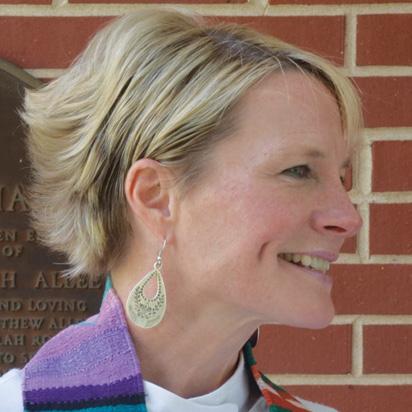
Odell McGhee II ’74 Distinguished Achievement
The fifth Black judge appointed to the district court in the state of Iowa, McGhee has a special interest in young people and equal justice for all. He provides leadership to countless commissions, nonprofits, and social service agencies and directs the Langston Hughes Company of Players in Des Moines.
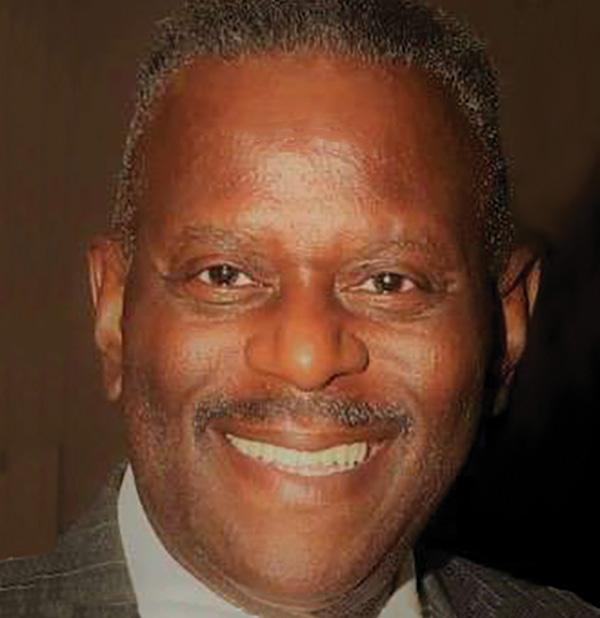
Justin Futrell ’16 Young Alumni Achievement
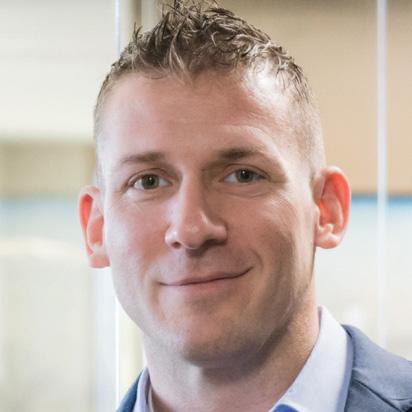
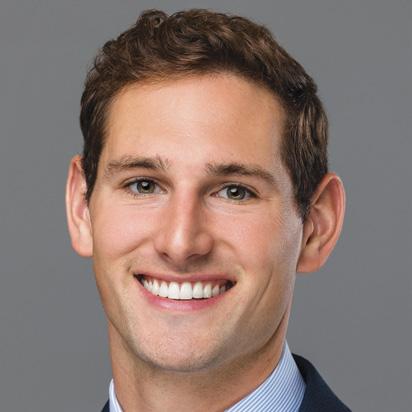
In an extraordinary feat of athleticism and fundraising in 2019, Futrell coordinated 25,000 pull-ups and raised $25,000 to build a water well in Tanzania. The project is now an annual event called Pull-ups for Tanzania, facilitated through Dean Riesen ’79’s Tanzania Water Fund. Futrell has raised $175,000 to date.
Dave Adkins ’62 Athletic Hall of Fame
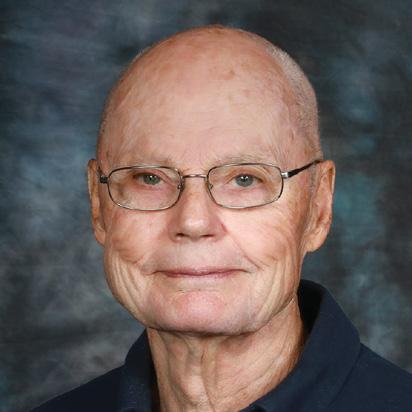
A first team all-Midwest Conference forward, Adkins netted 1,112 points in three seasons, ranking No. 14 on Cornell’s career list. He piloted the 1960-61 conference championship team to a school-record 18 wins and a berth in the NCAA College Division Regional, in which he was an all-tournament selection.
Eric Kulbe ’00
Athletic Hall of Fame
A two-time, all-conference baseball outfielder, Kulbe led NCAA Division III in stolen bases during the 1998 and 2000 seasons and holds Cornell records for steals in a career (143) and a season (44). At one point Kulbe stole 46 consecutive bases, the fifth-longest streak in Division III.
Trinity Tisue McWilliams ’00
Athletic Hall of Fame
McWilliams is the all-time record holder for most points (135) and goals (54) scored in Cornell women’s soccer history. The allregion honoree guided the Rams to three Iowa Conference Tournament berths and a program-best 15 wins in 1998.
47 CORNELL REPORT | FALL 2022
One Course SUMMER INSTITUTE
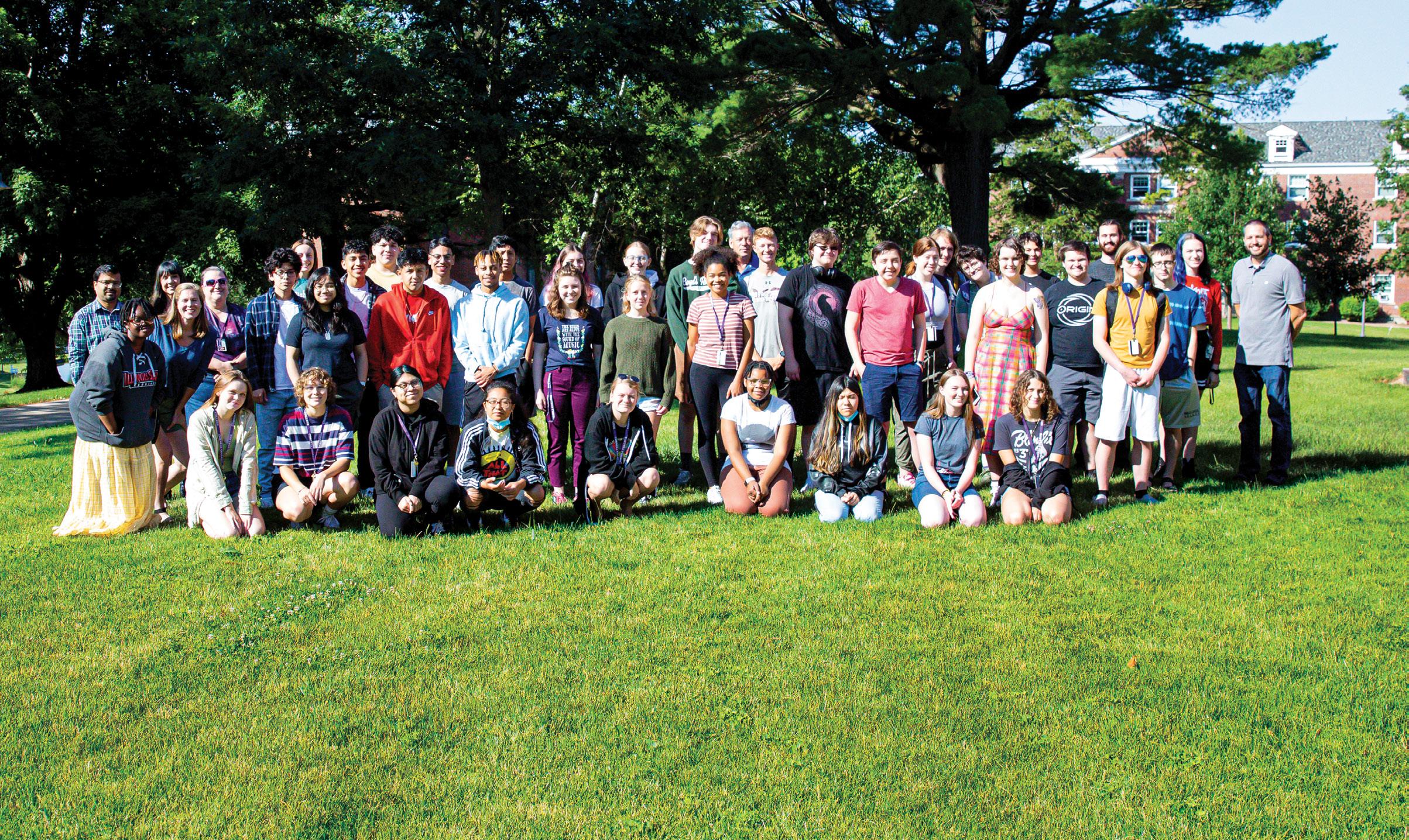
For ambitious high school students
After 20 years as head volleyball coach at her alma mater, Kennedy High School in Cedar Rapids, Iowa, and working for USA Volleyball’s Iowa Region for 11 years, Michelle Dye Goodall ’89 made the switch to a new team in 2019. She is coaching for USA Volleyball’s Paralympic Sitting Volleyball Team. She splits her time between Cedar Rapids and the Paralympic Training Site at the University of Central Oklahoma; they train year-round and won a gold in Tokyo. In addition, she is program manager for Beach ParaVolley programming, a relatively new sport, advocating for inclusion in the LA28 Games. She and Steve Goodall ’87 “have four grown kids, three kids-in-law, and now four (perfect) grandkids too.” Steve serves as the principal of the COMPASS Alternative Center in Marion, Iowa–an alternative high school.
Ignite curiosity.
Inspire an interest in college.
Share what an immersive experience

One Course At A Time can be.
Learn more @ crnl.co/ocsi
1990s
Kristin Cloyes Farr ’92, Boulder, Colorado, is a project coordinator at Jefferson County Public Library. Her projects focus on customer service; in particular, making their 11 libraries welcoming, easier to navigate, and less intimidating to new users. She’s married with a 9-year-old autistic son and an energetic 4-year-old black lab who keep her busy. “I’m lucky to be able to see many of my Cornell friends regularly and truly treasure the friends I made there.”
Matthew Mitchell ’92, Englewood, Colorado, spent the past 30 years of his professional career working in various roles in the criminal justice system. He recently parted ways with one of the leading electronic monitoring technology providers to start MJM Solutions Inc., which specializes
in wearable technology and mobile apps designed and built for the criminal justice and rehabilitation space. Ted Carr ’90 and Tracy Sefl Tandon ’93 are on his advisory board. This year brought Matthew opportunities to visit Cornellians in Atlanta, Chicago, Arizona, and to coordinate a weekend ski trip in Vail.
After 10 years in Korea and ending up as one of the top two English-speaking voice coaches there and starting a new career as a voiceover actor, Karen Lyu ’93 is starting over in Chicago, Illinois. “I love my new home, and it’s been a challenge as well,” she writes. She’s also co-chair of the Voice and Speech Teachers Association BizCore Committee, and feels it’s a nice way to give back in her 25th year as a holistic voice coach.
48
A year ago Brian Taylor ’93 and Amy Kober Taylor ’97 moved to Columbia, Missouri, where Brian became the vice president for enrollment and marketing at Central Christian College of the Bible. Amy continues to help lead The Little Sisters Fund, educating girls in Nepal. Their oldest daughter, Lael, was awarded a KennedyLugar YES Abroad scholarship through the U.S. State Department to spend her junior year in high school studying in Indonesia, “which both excites us and scares us to death!”
Instead of buying a convertible for her midlife crisis, Katrina Seekins Kobel ’94, Grapevine, Texas, decided to pursue a career in nursing. She was accepted into a nursing program right before COVID hit. In July she started a year-long residency at the University of Texas Southwestern Clements Hospital (in Dallas) in a Level II trauma emergency department. “I haven’t decided if I timed this perfectly with my youngest going off to college in the fall, or screwed up because my husband and I won’t be able to travel whenever we want. It was interesting being in school with kids the same age as my oldest. We definitely taught each other life lessons, which was awesome.”
Melissa Moffitt Winters ’94, Des Moines, Iowa, left her job of 20 years to take a position at Silent Rivers Design + Build as their design manager (and finance manager), working primarily on residential remodeling projects. “I’m finally in a place where I can dive back into traveling, and I’m starting big, planning a trip to Ghana in November with Craig Vickstrom ’92 and Angela Hegel Becker ’95!”
Roy Anneberg ’97 bought a house in Lakewood, Colorado, and ended 17 years teaching visual arts in Lakewood’s Bear Creek community. Now he’s teaching at D’Evelyn Junior/ Senior High as the middle school art and high school drawing instructor. He recently started taking postponed trips, including to France and a total
of seven states and seven countries. He is building a totem pole garden at his family’s mountain property; so far there are 16 totem poles made out of the stumps of dead beetle-kill pine.
After more than three years living in Ontario, Canada, Jalel Aossey ’97 and his family returned to U.S. soil to live in Canton, Michigan.
2021 was a big year for Mary Elliott ’98, Arvada, Colorado. She graduated with her doctorate in higher education in August of 2021. Then she and her partner, Eric, got married on Oct. 1, 2021, surrounded by some of her closest Cornell friends.
Dan Caropreso ’99, West Des Moines, Iowa, was appointed as the chief U.S. probation officer for the U.S. District Court in the Southern District of Iowa. Dan oversees approximately 60 staff in divisional offices in Des Moines, Davenport, and Council Bluffs.
RJ Holmes-Leopold ’99, Eagan, Minnesota, serves as president of the Liberal Arts Career Network (LACN). LACN is a consortium of 40 leading liberal arts college and university career centers preparing students to apply their liberal arts education to the world of work. He is director of the Carleton College Career Center.
2000s WEDDINGS
Alexandra Myers ’05 to Misha Osinovskiy, March 27, 2021
David Boussios ’09 to Kelly Higgins, June 18, 2022
BIRTHS
Zoe Anne Zipf, March 8, 2022, to Beckey Stoffel Zipf ’01 and Matt Zipf
Michelle Dye Goodall ’89 is coaching for USA Volleyball’s Paralympic Sitting Volleyball Team. They train year-round and won a gold in Tokyo. She’s also program manager for Beach ParaVolley programming, a relatively new sport advocating for inclusion in the LA28 Games.
Abigail Elizabeth Smith, Dec. 7, 2021, to Jamie Wallace Smith ’05 and Rik Smith
Axel Ray Baker-Newport, April 5, 2022, to Mark Baker ’06 and Shelby Newport ’06
Ava Kaye Spillyards, March 29, 2022, to Anna Skaggs ’07 and Joe Spillyards
Sebastian Vovk Netwal, April 21, 2022, to Daniel Netwal ’09 and Olga Vovk ’10
Citing the John Denver hit “Take Me Home, Country Roads,” Aaron Rosenthal ’01 moved to Harpers Ferry, West Virginia, “with my mountain mama (see song lyrics) of 10 years, our geriatric dog, Paul, and several citrus plants.”
Beckey Stoffel Zipf ’01, Prosper, Texas, welcomed her second child, Zoe, in March 2022, and reports that the baby adores her big brother, Oliver.
Emily Barbuto ’00, Ashgabat, Turkmenistan, completed a master’s degree in educational leadership through SUNY Buffalo State’s International Graduate Program for Educators, and is now the director of instruction at Ashgabat International School.
After 22 years, Arianne Hartlove Dooley ’00, Denver, Colorado, finally applied to graduate school. And in less than two days (“thank you Cornell for being speedy with my transcript!”), she was accepted. She’ll start working on her M.B.A. in August. Her 16-year-old son, Ciaran, spent a summer month in Zanzibar volunteering in turtle conservation.
Heather Carmichael Scoville ’00, Ladora, Iowa, ended her 17th, and final, year as a high school science teacher. She’s now working as a product manager for ACT. “My son finished his first year on the Hilltop and is part of the esports team and the choir. He loves Cornell just as much as I did, and that makes me happy.”
Former Alumni Board member Alice Juarez ’04, Dallas, Texas, appeared on TV news on June 21, 2022, helping to announce that children 6 months and older can get vaccinated against COVID-19 in Dallas County.
Alexandra Myers ’05, San Diego, California, is a family practice sports medicine doctor and went to the Tokyo Olympics to care for the USA Rugby team. She married Misha Osinovskiy on March 27, 2021, and regularly sees her brother, Marc Myers ‘05, who lives in Orange County.
Adam Eichhorn ’06, Marietta, Ohio, began a new career in January 2020 with the federal government as financial systems analyst with the Bureau of Fiscal Service. This fall marks his 11th year as an assistant football coach at Marietta College in Ohio. He and his wife, Andrea, celebrated their 11th anniversary in July. Their son, William, is 3 and their daughter, Areana, is 6.
49 CORNELL REPORT | FALL 2022
Tom Krell ’06, Los Angeles, California, defended his dissertation–”The Threat of Nihilism and the Prospect of Non-Nihilistic Metaphysics in Jacobi and Hegel”—and passed with distinction, completing a Ph.D. in philosophy at DePaul University in Chicago, Illinois. Krell began his philosophy studies at Cornell, when the Philosophy Department was rather colorfully composed of Dr. White, Dr. Brown, and Dr. Gray. Since graduating from Cornell, Krell has also garnered critical acclaim for his multimedia music and art project How To Dress Well.
David Boussios ’09, Washington, D.C., was hired as an economist for DecisionNext, where he will use his insight into the development of statistical models for ag commodities and advance the company’s efforts in the growing supply chain analytics space. David majored in economics and business at Cornell, and has master’s and doctoral degrees in agricultural economics. He spent six years in research science roles and economist functions in the USDA’s Office of the Chief Economist.
Sara Blaser Hamilton ’09, Titonka, Iowa, is working on a master’s degree in special education through Morningside University. This fall Sara took on a new role as the special education director in the school district where she teaches and coaches in northern Iowa. She and her husband have four children: Noah (10), Jordyn (8), Kinnick (4), and Emmett (2).
Myka Peterson Forrest ’09, Marion, Iowa, accepted the position of lead application developer for Vista Iowa, a software company based in Cedar Rapids that specializes in Iowa school business accounting and payroll solutions.
2010s
WEDDINGS
Ashley Crump ’13 to Charles Kolterman, April 2, 2022
Hannah O’Brien ’15 to Shawna Grittmann, March 11, 2022
Alexandra Place ’17 to John Thomas, July 9, 2022
BIRTHS
Madison Jean Arkle, Jan. 27, 2022, to Kelsey Feser Arkle ’10 and Jenny Arkle
Kyrie Dominique Deville, Aug. 15, 2020, to Jason Deville ’13 and C’niphia Jones Deville ’14
Philip Miller Kleine, March 2, 2022, to Kalissa Holdcraft Kleine ’13 and Philip Kleine
Lillian Shea, March 28, 2022, to Jacob Fields ’14 and Adrianne Isaacson
Sean Aodhan Howard, May 14, 2022, to Haley Severance Howard ’15 and Matthew Howard
Jacob Henry-Camille ’13, Pocono Summit, Pennsylvania, set up a projector in his backyard to watch the Fast & Furious movies with his wife, Leia Henry-Camille, Namita Shah ’12, and Tim Bingham ’13
Victoria Johnson ’13, Inkster, Michigan, graduated with a master’s degree in public affairs from the University of Michigan’s Gerald R. Ford School.
Dan Carney ’14, Chicago, Illinois, started a new role as a university recruiter for ZS Associates, a management consulting and professional services firm focusing on consulting, software, and technology. Dan is excited to bring his previous experience of working in higher education to his new role.
Maren Elnes-Kaufmann ’15 and Will Kaufmann ’16 moved to Portland, Oregon, and bought their first home. Maren is working as an architect at GBD Architects, while Will took a new role at KPD in their surety branch. They are loving being close to family in the Pacific Northwest.
Benjamin Blaser ’10 finished three years as an athletic director in Cairo, Egypt, and accepted a new two-year position as an athletic director in Chennai, India. His wife is a grade level leader.
Annie Armatage ’12 left Finland for sunny Santa Fe, New Mexico, to work as a program evaluator with the New Mexico Legislative Finance Committee.
Jason Deville ’13 and C’niphia Jones Deville ’14, Aubrey, Texas, celebrated their sixth wedding anniversary and 10th year of being together. In 2020 they welcomed a son into the world. Jason is thriving in the technology field and C’niphia is branching out: she is still an elementary educator; however, she recently became a licensed financial professional.
Haley Severance Howard ’15, Las Vegas, Nevada, and her husband, Matthew, welcomed Sean Aodhan Howard into the world on May 14. Haley enjoyed her summer break and the opportunity to get to know the baby and watch him grow. She works as a technical theatre instructional assistant and designer at the local high school.
Nathan Spalding ’15, Des Moines, Iowa, left his job of seven years at FoodCorps to start his career as a full-time potter with his new business, SadBoy Ceramics. In July he moved from his home studio to a larger commercial studio and retail space in Des Moines.
Zach Becicka ’16, Cedar Rapids, Iowa, accepted the head coaching position at Cedar Rapids Prairie High School for the newly established girls wrestling program.
50 ALUMNI NEWS
Instead of buying a convertible for her midlife crisis, Katrina Seekins Kobel ’94 decided to pursue a career in nursing.
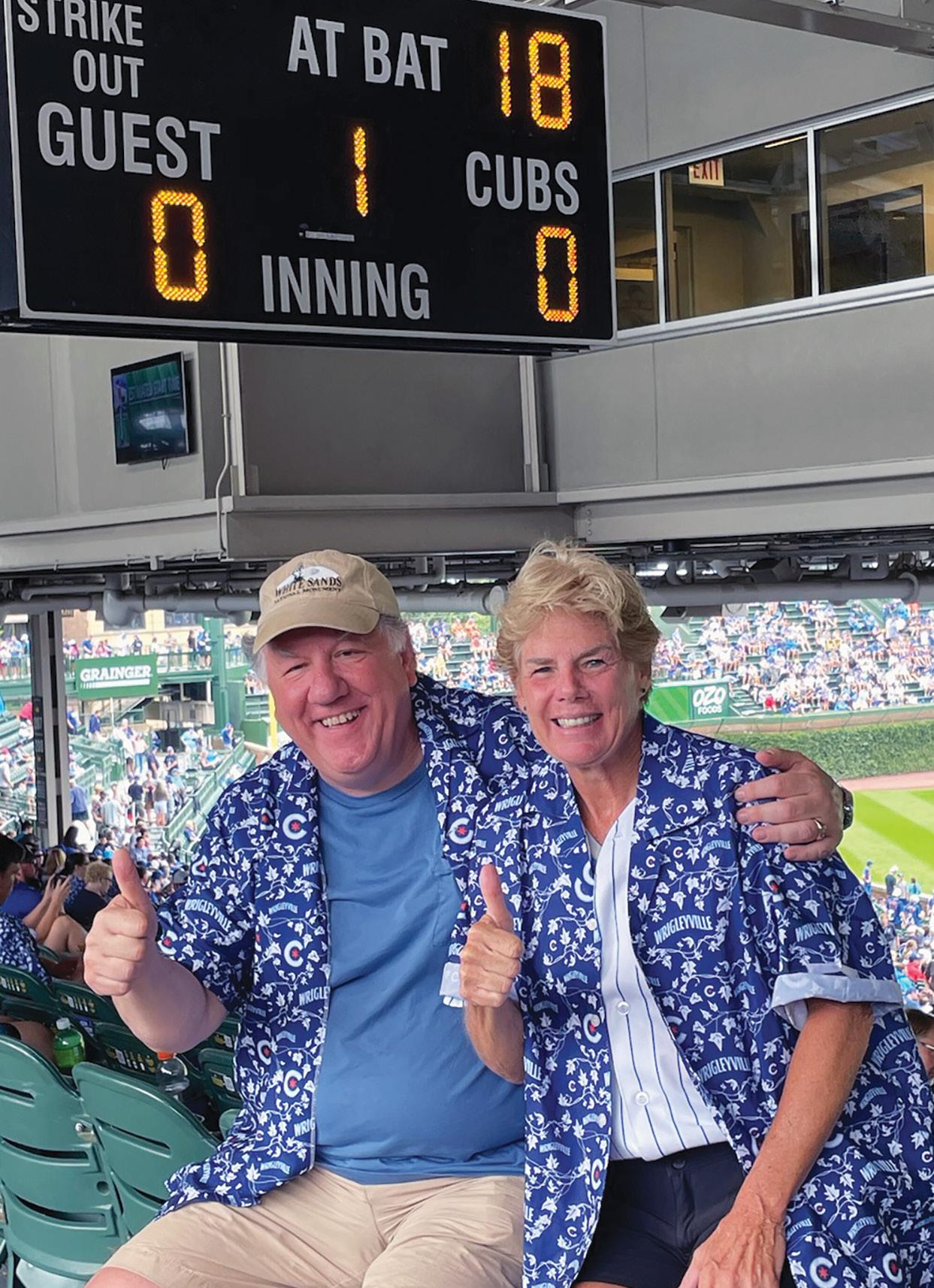
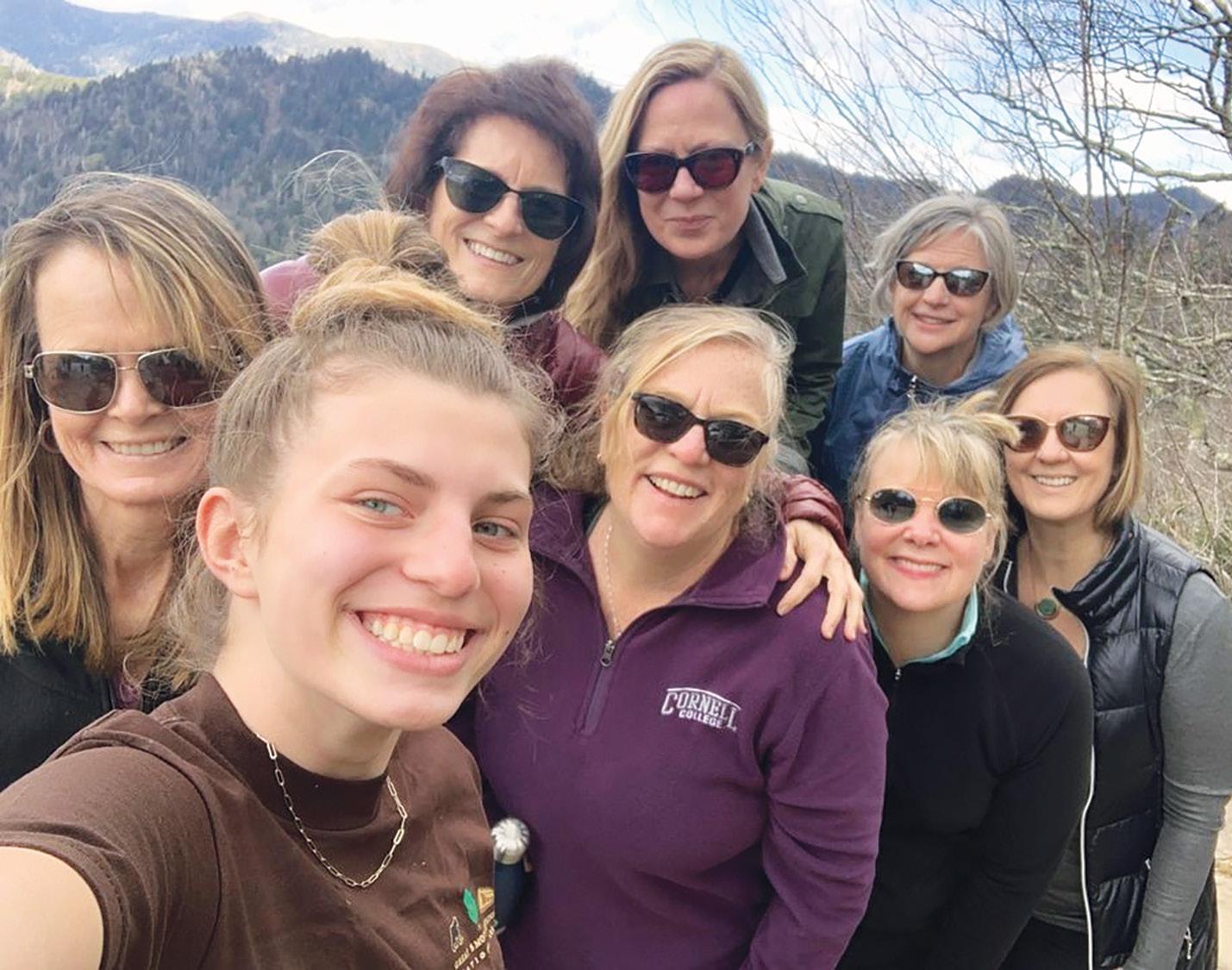
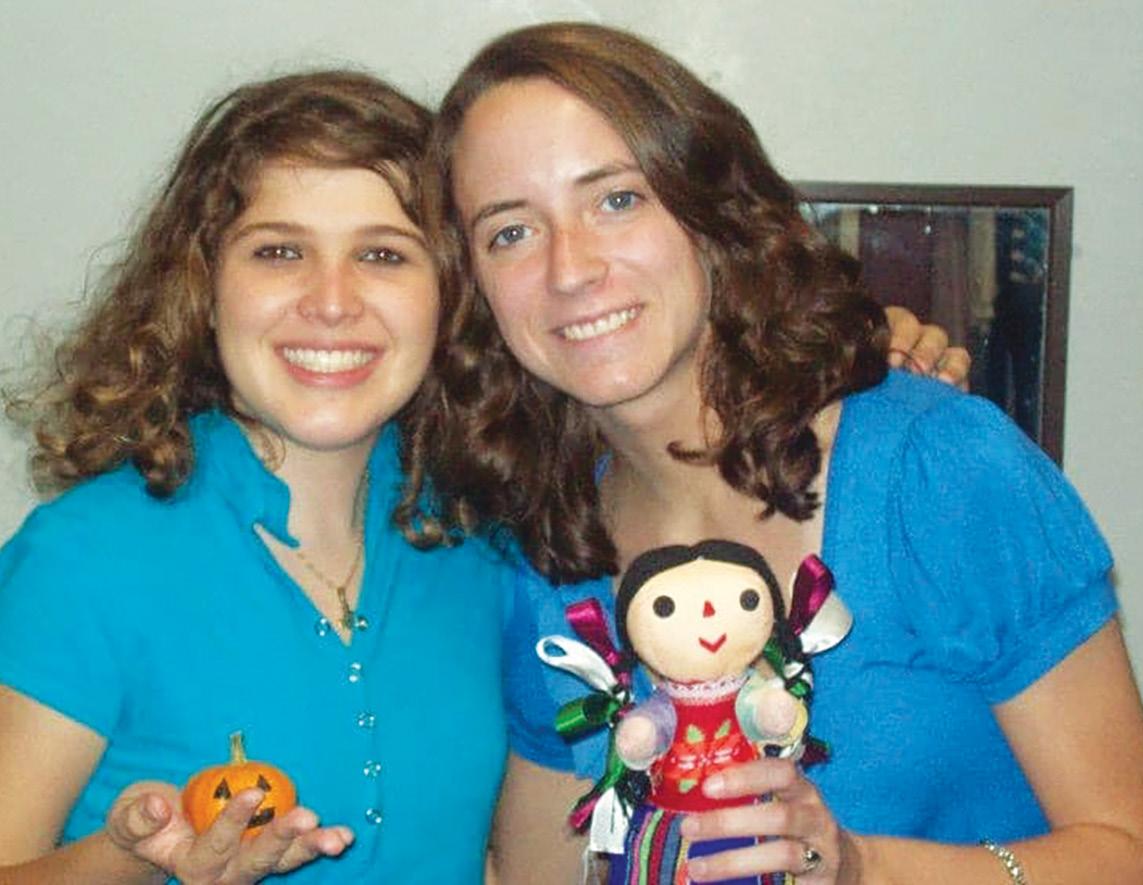
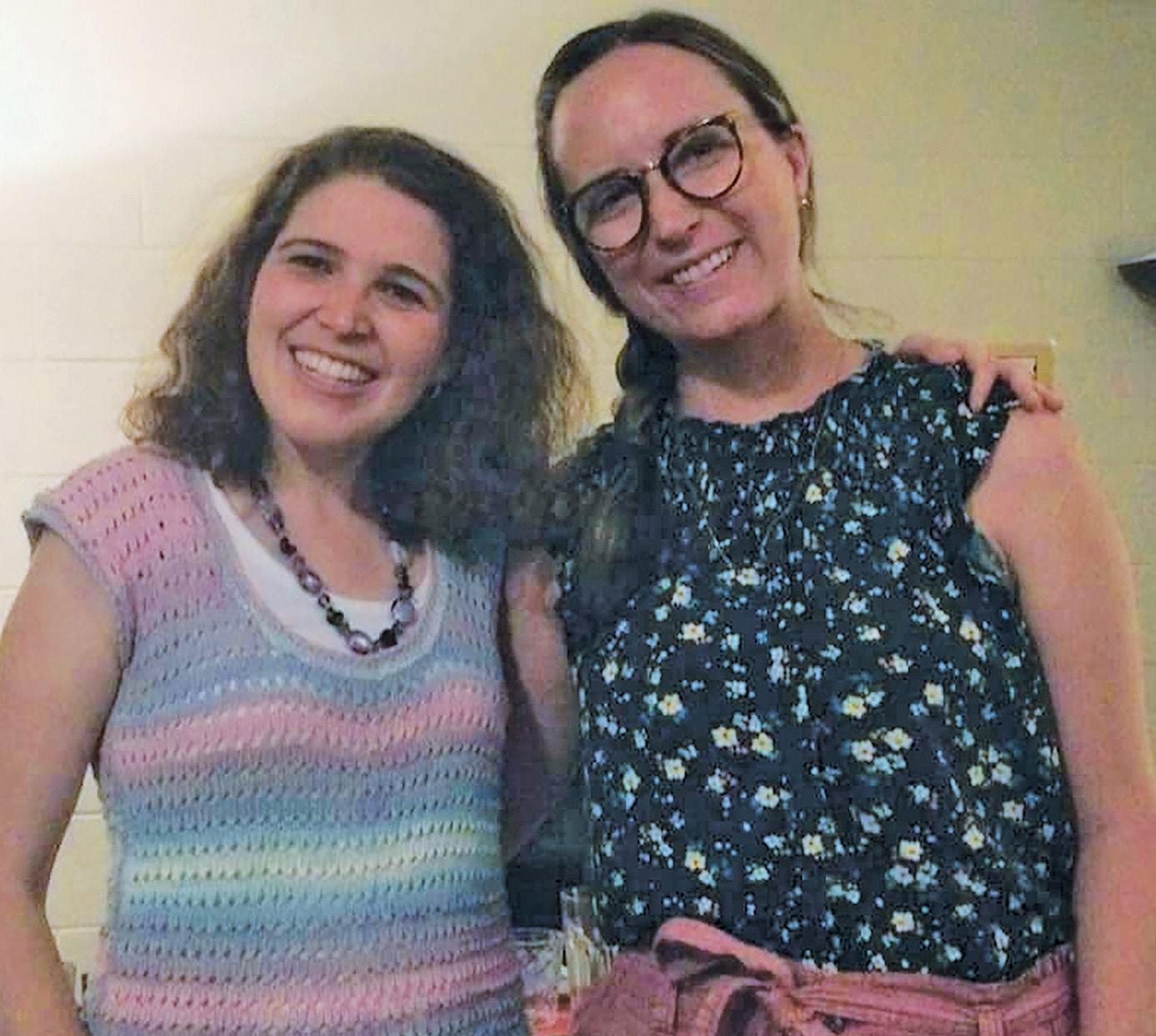
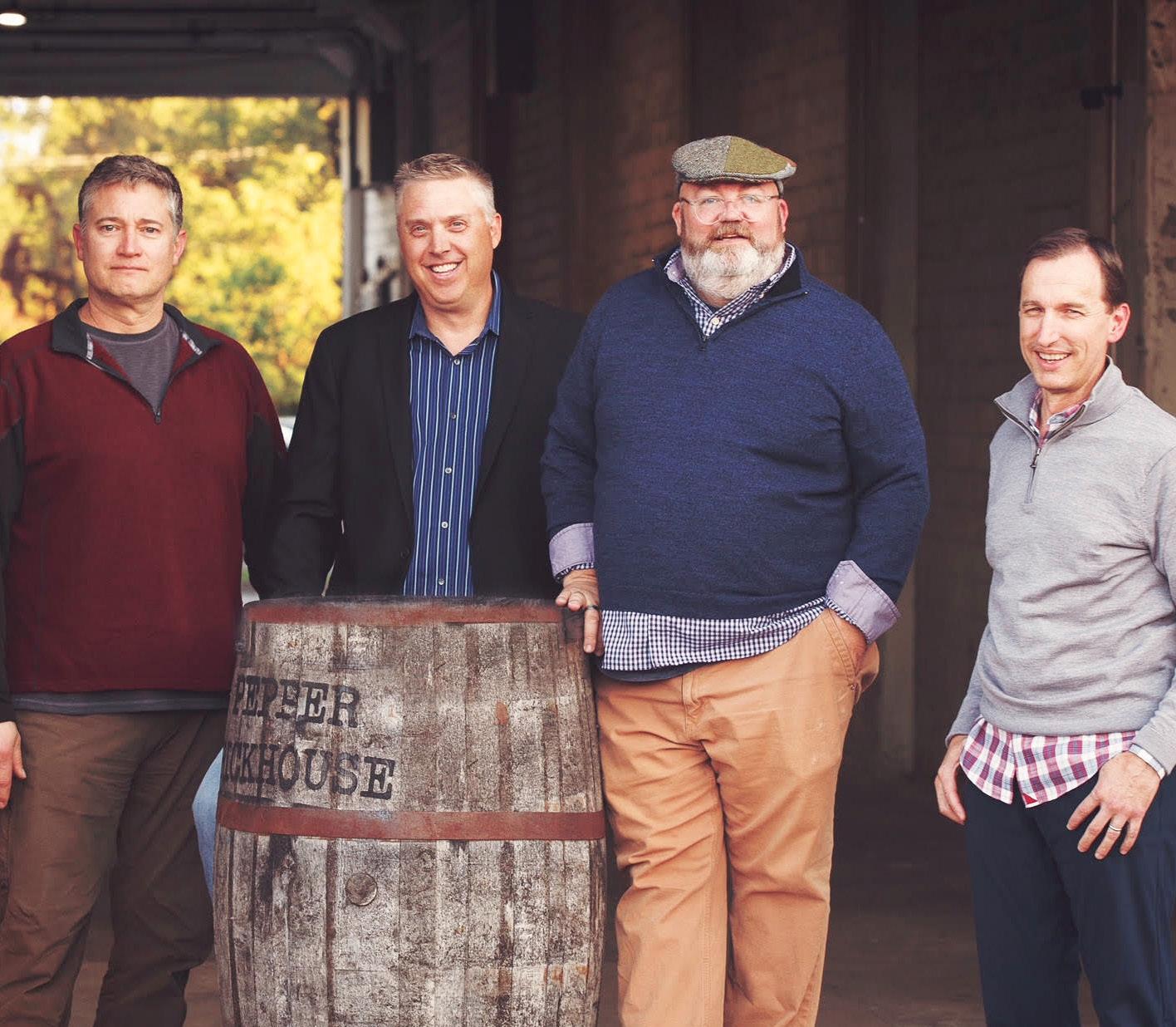 The Cornell Gal Pals have been meeting annually for years, most recently in North Carolina. Back row: Michelle Krezek ’85, Liz Daleske ’85, Diana Daskalos Corcoran ’87. Middle row: Addie Wallace Morrison ’87, Elizabeth Heffernan ’88, Maureen Johnson ’87, Liana Overley Allison ’89. Front row: Michelle’s niece and, hopefully, future Cornellian Olivia Tompkins.
Ken Heintz ’84 and Michaela Crowley Havemann ’84 ran into one another at a recent Cubs game. The last time these classmates saw each other was at their Cornell graduation.
In Oct of 2021 Joshua Urban ’93, Scott Kirkpatrick ’93, Brian Taylor ’93, and Todd Watson ’93 (from left) gathered on the Bourbon Trail and the running of horses at Keeneland in Lexington, Kentucky.
The Cornell Gal Pals have been meeting annually for years, most recently in North Carolina. Back row: Michelle Krezek ’85, Liz Daleske ’85, Diana Daskalos Corcoran ’87. Middle row: Addie Wallace Morrison ’87, Elizabeth Heffernan ’88, Maureen Johnson ’87, Liana Overley Allison ’89. Front row: Michelle’s niece and, hopefully, future Cornellian Olivia Tompkins.
Ken Heintz ’84 and Michaela Crowley Havemann ’84 ran into one another at a recent Cubs game. The last time these classmates saw each other was at their Cornell graduation.
In Oct of 2021 Joshua Urban ’93, Scott Kirkpatrick ’93, Brian Taylor ’93, and Todd Watson ’93 (from left) gathered on the Bourbon Trail and the running of horses at Keeneland in Lexington, Kentucky.
51
Cornell roommates Ariadne Penalva ’15 and Bridget Ollesch ’15 have remained close friends since they left Cornell. In fact, Bridget is finishing her medical residency in neurology, while Ariadne just completed her doctorate in neuroscience, both in Utah. This is their first and most recent photos together, 10 years apart.
Back row (from left): Rick Snyder (green cap), Karen Ippen, John Ippen ’77, Greg Ippen ’73, Jonathan Brand, A.J. Plummer, DeLoe Mathatas
Middle row (from left): Warren Mack ’66, Linda Pfaff Mack ’69, Virginia Shannon Cameron ’71, Mary Ann DeWerff Snyder ’71, Marta Wherry Mathatas ’74, Doug Cameron ’70, Rachelle LaBarge, Karen Hoffman, Gwen Fife Ippen ’72
Front row (kneeling, from left): Carmelita Casal, Nicole Casal ’18, Philip Casal, Amy Harrison ’18, David Hoffman ’65
Cornell alumni trip enticed 21 to spend a week in Normandy
 By Linda Pfaff Mack ’69
By Linda Pfaff Mack ’69
“When you leave the hotel, always turn left,” Chiara, our lovely guide for our week in Normandy, advised in her lilting Italian-accented English.
She was right. Turning left took us on cobblestone sidewalks into the heart of flower-bedecked Honfleur, a charming medieval tourist town centered on a picturesque harbor lined with tall narrow buildings and inviting restaurants. Perched on the Seine where it flows into the Atlantic, Honfleur’s watery light and views attracted the
artists who became France’s famous Impressionists. It couldn’t have been a better home base for Cornell College’s alumni trip, which was graciously hosted by President Jonathan Brand, who holds a master’s degree in French literature, and his wife, Rachelle LaBarge. Each of the seven days brought a new adventure.
Monday was a walking tour of Honfleur led by Anna Maria, resident of a nearby village who knows and loves Norman history. It ended at St. Catherine’s, France’s largest wooden church. Its timber ceiling, resembling an upside-down hull,
displays the work of local shipbuilders.
Tuesday, Steven, another knowledgeable guide, recounted the grim and heroic history of the Normandy beaches, including Pont du Hoc with its bomb-damaged bunkers.
Wednesday we enjoyed a cooking demonstration and lunch at a 10th-century castle before a stop in Le Havre at the Musee Malraux of Modern Art, France’s first museum built after World War II.
Thursday took us to the ancient pilgrimage site of Mont-Saint-Michel, which rises out of a granite island
52
in a spectacular tidal basin off the coast near Brittany.
On Friday Anna Maria returned to take us to the compelling Caen Memorial Museum, followed by an outdoor feast at a Calvados estate and an afternoon viewing of the 230-foot long Bayeux Tapestry, stitched in the 11th century to commemorate the Norman Conquest of England.
Saturday’s free day allowed us choices. Some traveled to Giverny to see Monet’s garden and house. Others stayed in Honfleur to visit more of its many museums.
Every day included delicious food, usually in lovely settings, and great conversations with fellow Cornellians. After our last group meal, our younger participants, Nicole Casal ’18 and Amy Harrison ’18, suggested we all ride the huge Ferris wheel directly across from our hotel. It carried us upward to enjoy views of the Seine, the spectacular new bridge that spans it, the lovely hills of Honfleur—and the smiling faces of our fellow travelers.
Linda Pfaff Mack ’69 was a Minneapolis Star-Tribune architectural columnist. She is married to Warren Mack ’66.
Maria Goodfellow ’16 departed her Peace Corps position and moved to Durham, North Carolina, to pursue a master of public policy degree at Duke University.
Amy Robasse ’16, Amana, Iowa, accepted a job as the executive director of the Iowa Statewide Independent Living Council.
Andrea Corbet ’17, Albuquerque, New Mexico, is completing her Ph.D. program and will receive her degree in biomedical science with a focus on cancer biology. She intends to pursue a postdoc and continue doing cancer research.
Alexandra Place ’17, Cedar Falls, Iowa, married John Thomas on July 9, 2022. They met on a Cornell College visit in 2013. John didn’t go to Cornell, but they were reacquainted in 2016 when John transferred to Mount Mercy University.
Sara Renaud ’18, Charlotte, North Carolina, served as the interim museum director for the Floyd County Museum in Charles City, Iowa, in the first half of 2022. Then she moved to North Carolina in June to start work at the Mint Museum as the visual resources coordinator.
Nicola Etter ’19, Chicago, Illinois, obtained her certification in data analytics in May, which enabled her to make a career switch. She landed a job as a full-time remote data analyst for the adtech company Criteo.
After
22 years, Arianne Hartlove
Dooley ’00 finally applied to graduate school. And in less than two days (“thank you Cornell for being speedy with my transcript!”), she was accepted. She’ll start working on her M.B.A. in August.
2020s
Abigail Nelson ’20, Glen Ellyn, Illinois, accepted a position at Oregon State University as the coordinator of athletic academic support programs.
Adam Plotkin ’20, Bethesda, Maryland, finished a two-year research fellowship at the National Institutes of Health in the Molecular and Clinical Nutrition Laboratory. He’s now attending the Medical College of Wisconsin to pursue a doctorate of medicine. He’s been commissioned into the U.S. Army as a Second Lieutenant and will serve as an Army physician once his schooling is completed.
Shelby Broaddus ’21, Houston, Texas, accepted a position as a wardrobe assistant on a brand new Disney On Ice tour featuring “Encanto” and “Frozen.”
Bennet Goldberg ’21 was hired after graduation as the props craftsperson at Syracuse Stage, a professional theater in Syracuse, New York. While there Bennet applied to Yale’s props certificate program. “Despite the fact that only one student is selected for the program each academic year, I was the one to be accepted to the David Geffen School of Drama at Yale for this upcoming academic year.”
Madeleine Koenigsberg
’21 accepted a position as the event coordinator for the Sioux City Country Club in Sioux City, Iowa. Madeleine also signed a publishing deal for a first book with Austin MaCauley Publishers, and is planning at least two others.
Robin Nilsson ’21, Coralville, Iowa, writes that finding a new social circle was something she didn’t know if she would be able to do, especially with COVID-19 still being a concern for many. “In order to make friends, I started volunteering, attended local events frequently, and applied to join several local interest groups. After nine months I was starting to feel hopeless, when suddenly I met several awesome people all at once while volunteering! Now, I see them every week for Taco Tuesday, and we often go to weekend events together.”
Robin also joined Cornell’s Alumni Board, got accepted into grad school for a double master’s program, and spoke at a few work-related conferences.
After graduating in December 2021 Tyson Williams ’21, Lisbon, Iowa, started working as an admissions counselor for Cornell. This fall he’ll be attending the University of Iowa College of Law on a full tuition scholarship.
Frank Milella ’22 is teaching physical education at Matthews Middle School in Island Lake, Illinois. He’s also the head coach of the wrestling program there, and an assistant head coach for the Wauconda High School football program.
53 CORNELL REPORT | FALL 2022
George Duffy ’42
George Duffy ’42, a recognized expert on shock physics, died June 2, 2022, at the age of 101.
Duffy was a professor at South Dakota State University in Brookings, teaching chemistry from 1945 to 1958 and physics from 1959 to 1991. According to his official obituary, he authored more than a dozen physics textbooks, as well as more than 75 academic articles and other professional publications. His most recent text, “Modern Physical Chemistry: A Molecular Approach,” was published in 2012.
He grew up on a farm in Delaware County, Iowa, where he attended a one-room schoolhouse and enjoyed building technological projects and conducting experiments, often with his brother Loren Duffy ’41. At Cornell he participated in the wind ensemble and the Gamma Tau Pi fraternity, graduating Phi Beta Kappa. He then attended Brown University, transferred to Princeton University, and from there received a master’s degree in 1944 and a doctoral degree in 1945, both in physical chemistry.
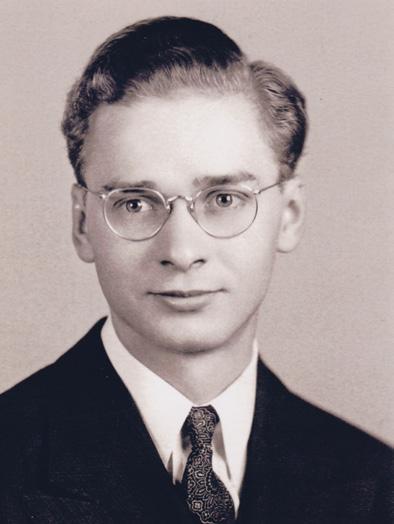
He and his first wife, Helen, raised three children. Duffy enjoyed gardening, ham radio, stamp collecting, and progressive politics.
He is survived by his second wife, Joan Morgan; a daughter; a son; three granddaughters; and three great-grandsons.
Bruce R. Eicher ’54
Prominent organist and educator Bruce R. Eicher ’54 died June 22, 2022, at age 90. He was a faculty member at Johns Hopkins’ Peabody Institute music conservatory and, for nearly six decades, organist and director of music at Grace United Methodist Church and organist at Beth El Congregation, both in Baltimore, Maryland.
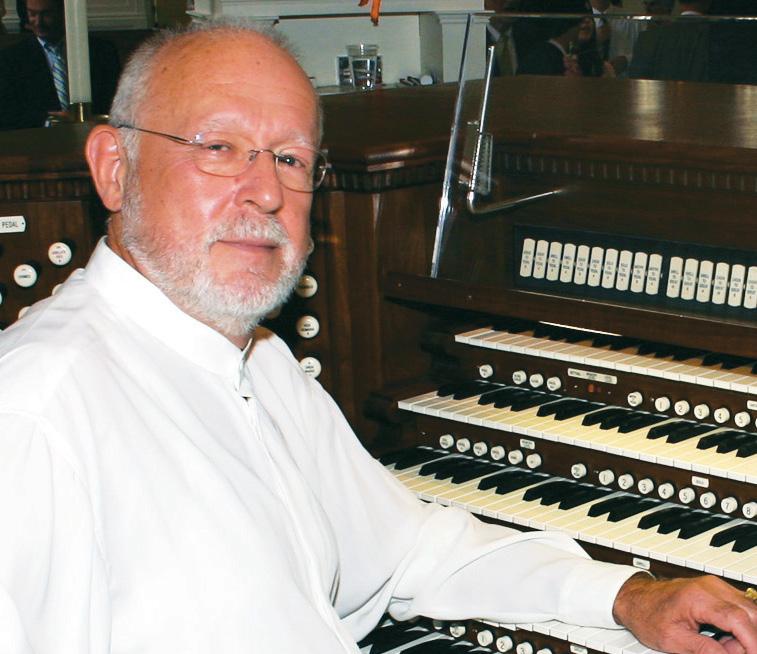
An Iowa native, Eicher assumed his first position at age 13 as an assistant organist. He began formal organ study at Cornell College as a student of Eugene Devereaux. He completed his degree at the Curtis Institute of Music, where his studies were interrupted when he was drafted into the Army. He earned his master’s degree at the Peabody Institute and undertook summer study in France with Nadia Boulanger.
In addition to performing as a recitalist, Eicher held three long-term positions: head of the Ear Training Department at the Peabody Institute (28 years, retiring in 1997); organist and director of music at Grace United Methodist Church, Baltimore (55 years, retiring in 2013); and principal organist at Beth El Congregation, Baltimore (56 years, retiring in 2019).
At Grace, he expanded the music program to include choirs for adults, youth, and children, as well as handbell ensembles. He was active in starting an AIDS ministry and also founded a Sunday afternoon concert series at Grace, which eventually included 15 annual French organ marathons.
He is survived by a husband, daughter, son, three grandchildren, and two great-grandchildren.
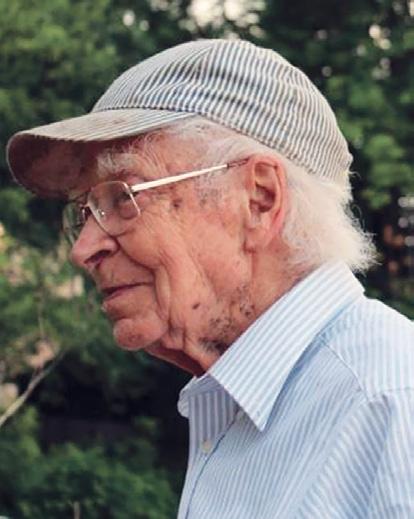
Duane Carlson ’55
Duane Carlson ’55, a pioneer in developing and promoting ways for all Americans to achieve and maintain healthy lifestyles, died Aug. 4, 2022, at age 89.
For more than 20 years Carlson used his platform as vice president of national communications for Blue Cross and Blue Shield to focus Americans’ attention on the role of diet, exercise, stress management, the environment, and other personal behaviors on their health and fitness. He joined the national office of Blue Cross in 1966, where he created the focus on healthy lifestyles, a discipline that rarely, if ever, had been formalized by a healthcare organization. He developed a series of books and multimedia programming aimed at helping millions of Americans. He worked with the President’s Council on Fitness and Sports and the U.S. Olympic Committee, testified before House and Senate committees, served on the National Health Council and the Ad Council, and worked with TV personality Fred Rogers.
Carlson was a highly engaged Cornell student—a Milt, Cornellian editor, Oratorio singer, intramural player, Husk and KRNL participant, and holder of the Men’s Senate key—and he graduated Phi Beta Kappa with degrees in English and sociology.

He and his wife and classmate, Ann Holcomb Carlson ’55, hosted many, many Cornell events for alumni and students in Chicago. He received a Cornell College Leadership and Service Award in 2015. Carlson is survived by his wife of 67 years, daughter Pam (married to Dale Carhill ’85), son Steve, three grandchildren, and a brother.

In memoriam
54 ALUMNI NEWS
Deaths
Mary Bacon Albrecht ’40, Beaverton, Oregon, Dec. 15, 2021
Helen Harbour Young ’43, Des Moines, Iowa, April 7, 2022
Richard Blakinger ’44 , Willow Street, Pennsylvania, June 23, 2022
Alice Whitehead Purnell ’46, Rockford, Illinois, Aug. 1, 2022
Grace Droegemueller Miller ’47, Janesville, Wisconsin, July 6, 2022
Martha Cooper Burns ’48, San Antonio, Texas, Feb. 1, 2022
Jack Campbell ’49, Langhorne, Pennsylvania, March 12, 2022
C. Edward Chapman ’50, Clemmons, North Carolina, March 3, 2022
Phyllis Crosley ’50, Elmhurst, Illinois, March 15, 2022
Mary Ann Hoye Grinde ’50, Cedar Rapids, Iowa, March 10, 2022

Ronald Nauman ’50, Edina, Minnesota, March 1, 2021
Elizabeth Barrett Schofer Olm ’50, Huntsville, Texas, May 1, 2022
Margaret Rowley Ruppert ’50, Cedar Rapids, Iowa, March 30, 2022
C. Alan Riedesel ’51, Dunkirk, New York, June 9, 2022
Patricia Farley Schmitz ’51 , Clinton, Iowa, Aug. 5, 2022
Velma (Iris) Lochner Witt ’51 , Battle Creek, Iowa, April 21, 2022
William Glasgow ’52 , Menomonee Falls, Wisconsin, June 18, 2022
Jack Stanton ’53, Cedar Rapids, Iowa, May 29, 2022
Gary Holthaus ’54 , Red Wing, Minnesota, July 5, 2022
Elizabeth Weiss Kester ’54 , Denver, Colorado, March 23, 2022
Mohssen Nejad ’54 , McLean, Virginia, Jan. 22, 2021
James Claypool ’55, Woodstock, Illinois, June 10, 2022
David Donkle ’55, Hamilton, Montana, Oct. 6, 2021
Cora Breen Claypool ’56, Woodstock, Illinois, April 11, 2022
David Elder ’56, Sun Prairie, Wisconsin, July 1, 2019
Janet Stitzel Gray ’56, Colorado Springs, Colorado, April 14, 2022
William Hofstetter ’56, Altoona, Florida, July 22, 2022
Gary Clark Lupton ’56, Loveland, Colorado, April 7, 2022
Betty Nicholson Manousselis ’56, Park Ridge, Illinois, June 11, 2022
Marilyn Kelley Regan ’56, Old Saybrook, Connecticut, March 21, 2022
Nancy Erickson Hart ’57, Normal, Illinois, April 22, 2022
Jerrie Moore ’57, Albuquerque, New Mexico, June 19, 2022
Sue Knox Powell ’57, East Lansing, Michigan, July 16, 2022
Mary Lucille Brooks ’58, Arizona City, Arizona, June 2, 2022
Richard Humphrey ’58 , Chattanooga, Tennessee, March 28, 2022
Patricia Goebel Luhrs ’58, Urbandale, Iowa, March 27, 2022
Gary Grau ’59, Olympia, Washington, May 3, 2022
Geraldine Bartow Prickett ’59, East Moline, Illinois, Oct. 3, 2021
Grady Merriman ’60, Porters Neck, North Carolina, May 10, 2022
Edwin Sublett ’65, Lake Forest, Illinois, March 17, 2022
Claudia Carter Symons ’67, Richardson, Texas, May 9, 2022
Ronald Vane ’67, Redwood City, California, July 6, 2022
Susan Chapman-Dyson ’69, Gateshead, England, April 9, 2022
Gayle Arthur Goold ’69, Paxton, Illinois, May 17, 2022
Catherine Wendt Fox ’70, Chicago, Illinois, July 26, 2022
Nancy McElwain ’72 , Boulder, Colorado, July 24, 2022
Nancy Flint Glick ’76, Havana, Illinois, June 14, 2022
David Simmons ’76, Alexandria, Virginia, Feb. 19, 2022
Leonard Tischleder ’78, Carver, Minnesota, March 21, 2021
Thomas Young ’78, Warwick, Rhode Island, July 22, 2022
Henry Carson ’83, Cedar Rapids, Iowa, May 14, 2022
Elizabeth Gassler Miller ’83, Appleton, Wisconsin, May 10, 2022
Brian Flynn ’88, Green Bay, Wisconsin, May 16, 2022
Frances Kenney ’92 , Iowa City, Iowa, July 30, 2022
Douglas Ricklefs ’93, Muscatine, Iowa, April 11, 2022
William Wilson ’95, Tucson , Arizona, March 25, 2022
Monica Heersink ’02 , Estes Park, Colorado, Sept. 5, 2020
55 CORNELL REPORT | FALL 2022
Hope
By Deborah S. Prespare ’98
My dad’s job relocated us to Riyadh, Saudi Arabia, when I was 5. Shortly after we arrived I tagged along when my dad went grocery shopping. In South Korea, when I did this, shop owners pinched my cheeks and gave me candy. There were no candy treats for me in Riyadh. And there certainly wasn’t any cheek pinching.
I held my dad’s hand as we walked the store’s aisles. On the shelves packages were covered with black scribbles. I saw in some spots, where there were fewer layers of ink, fragmented images of women and girls. I felt so small. It wasn’t lost on me, even at 5, that marking out females on all these imported goods was vital enough to devote someone’s time. My dad squeezed my hand and told me we’re lucky we’re from a country where there’s separation between government and religion, where extreme ideas don’t dictate people’s lives.

When I was 16 I worked my first summer job at the American Embassy in Nairobi, Kenya, another city my dad’s work took us to. This was before an extremist group bombed the embassy in 1998. It was my first day, and I was covering the phones in the medical unit when a call came in from a consulate in a neighboring country. The doctor on the phone explained that a patient had an ectopic pregnancy and needed to be medevacked for an emergency abortion. My heart racing, my hands shaking, I accidentally lost the call when transferring it. The doctor in our medical unit told me not to worry, called the other doctor back, and the medevac coordination got underway. There was such decisiveness, urgency, and compassion on the phone lines that day.
I think about the juxtaposed treatment of women in these moments—from erasing all women to racing to save a woman’s life. I think about my first philosophy class with Paul Gray, and other philosophy classes at Cornell where we challenged ideas and beliefs, including our own. And I think about how some students dropped these classes because they didn’t want to challenge or question their beliefs.
A hesitancy to question can let the pernicious seeds of extremism take root. Extremism isn’t just a danger happening elsewhere. The storming of the U.S. Capitol. Attacks on people of color. Assaults on protestors. The struggle for human rights and protections. Extremism is happening right here too.
What gives me hope that this country can be the country my dad described to me in that store in Riyadh, when I needed comforting after seeing woman after woman, girl after girl blotted out, is that most of us, for our various reasons, felt compelled to stay in those classes.
Together in those Cornell classes, we tried to understand the world as objectively as we could no matter how uncomfortable it got for us personally.
I keep reminding myself that most of us stayed to challenge ideas and beliefs, that only a few chose not to engage. So long as the scales remain tipped this way, there’s hope. Deborah S. Prespare ’98 has an MA in writing from Johns Hopkins University, and in her personal time, she writes short stories, dozens of which have appeared in literary journals.She also oversees a statistics function as an associate director at the Federal Reserve Board. She relies on the critical thinking skills she developed while majoring in economics and philosophy at Cornell for this role as well as in her personal writing.
56 LAST WORD
“I want to show my parents that their sacrifices for me will be worth it. The scholarships that I have received from donors are helping me do just that. We are indebted to you for the generosity you have provided me and my family. Thank you so much! Mahalo nui loa!”


FROM: He and his family immigrated from the Philippines to Waipahu, Hawaii MAJOR: International relations MINOR: Philosophy ACTIVITY: Cornell LEADS (Leadership, Entrepreneurship, And Distinctive Service)
Chad
Domingo ’24 Your Cornell Fund gift helps provide scholarships for students like Chad, and we are grateful for your support. Make your gift today at crnl.co/give alumni.cornellcollege.edu
Signatures of the members of the Class of 2026 adorn The Rock as the 170th school year began in August. Signing The Rock is a New Student Orientation activity sponsored by the Alumni Office, sharing the history and traditions of one of our oldest campus residents with our newest ones.

ORG. U.S. POSTAGE PAID
600 FIRST STREET SW MOUNT VERNON,
52314–1098
NON-PROFIT
CORNELL COLLEGE
IA
DEE ANN REXROAT
’82










 ASSISTANT EDITOR Lisa Gray Giurato
DESIGN
Amy Belice Graphic Design
CLASS NEWS CONTRIBUTORS
Maxwell Love Joshua Waldorf
ASSISTANT EDITOR Lisa Gray Giurato
DESIGN
Amy Belice Graphic Design
CLASS NEWS CONTRIBUTORS
Maxwell Love Joshua Waldorf

 ARDEN KWAN ’83
ARDEN KWAN ’83


















 By Christi Johnson
By Christi Johnson
 Associate Professor of Kinesiology Christi Johnson
Gabrielle Zeger ’21 and Gabie Campbell ‘18 meditate inside Allee Chapel in 2018, a practice that Professor Johnson recommends to increase stillness in an anxious mind.
Associate Professor of Kinesiology Christi Johnson
Gabrielle Zeger ’21 and Gabie Campbell ‘18 meditate inside Allee Chapel in 2018, a practice that Professor Johnson recommends to increase stillness in an anxious mind.















 RHAWN DENNISTON
Students in the Geology of New Zealand course draw geologic maps on the shore of Golden Bay.
RHAWN DENNISTON
Students in the Geology of New Zealand course draw geologic maps on the shore of Golden Bay.

 ROBYN SCHWAB AARON ’07
ROBYN SCHWAB AARON ’07



 MAREN HANSEN ’74
Professor of Geology Emily Walsh and her students study rock specimens—in and out of the classroom—without distraction from other courses.
MAREN HANSEN ’74
Professor of Geology Emily Walsh and her students study rock specimens—in and out of the classroom—without distraction from other courses.

































 The Cornell Gal Pals have been meeting annually for years, most recently in North Carolina. Back row: Michelle Krezek ’85, Liz Daleske ’85, Diana Daskalos Corcoran ’87. Middle row: Addie Wallace Morrison ’87, Elizabeth Heffernan ’88, Maureen Johnson ’87, Liana Overley Allison ’89. Front row: Michelle’s niece and, hopefully, future Cornellian Olivia Tompkins.
Ken Heintz ’84 and Michaela Crowley Havemann ’84 ran into one another at a recent Cubs game. The last time these classmates saw each other was at their Cornell graduation.
In Oct of 2021 Joshua Urban ’93, Scott Kirkpatrick ’93, Brian Taylor ’93, and Todd Watson ’93 (from left) gathered on the Bourbon Trail and the running of horses at Keeneland in Lexington, Kentucky.
The Cornell Gal Pals have been meeting annually for years, most recently in North Carolina. Back row: Michelle Krezek ’85, Liz Daleske ’85, Diana Daskalos Corcoran ’87. Middle row: Addie Wallace Morrison ’87, Elizabeth Heffernan ’88, Maureen Johnson ’87, Liana Overley Allison ’89. Front row: Michelle’s niece and, hopefully, future Cornellian Olivia Tompkins.
Ken Heintz ’84 and Michaela Crowley Havemann ’84 ran into one another at a recent Cubs game. The last time these classmates saw each other was at their Cornell graduation.
In Oct of 2021 Joshua Urban ’93, Scott Kirkpatrick ’93, Brian Taylor ’93, and Todd Watson ’93 (from left) gathered on the Bourbon Trail and the running of horses at Keeneland in Lexington, Kentucky.
 By Linda Pfaff Mack ’69
By Linda Pfaff Mack ’69









